About this Blog: Varanasi or Kashi has been one of our favourite places to visit. We always manage to find a perfect serenity in the midst of all the chaos of this spiritual city of India, something that is hard to find. We can simply spend hours in the ghats of Varanasi seeing the city come alive before us. This Varanasi blog is about the Ghats in Varanasi and their significance.
Did you know that there are 87 ghats in Varanasi?
I had visited Varanasi for the first time when I was quite small. It was a time when middle-class Bengali families would go on vacations every year during the holidays. Those were fond memories. The entire family including grandparents, uncles, aunts and cousins would all travel to some distant place by the Indian train carrying the suitcases and large holdall bags. The cacophony, chatter and fun would make the long train journeys immensely enjoyable. It was during one such family vacation I had visited Varanasi for the first time. To me, Varanasi had always been the place where the famous Bengali sleuth Feluda had solved mysteries. It was the place of Bishwanath Gali (a narrow alley in Benaras) and the famous Dashshwanedh Ghat.
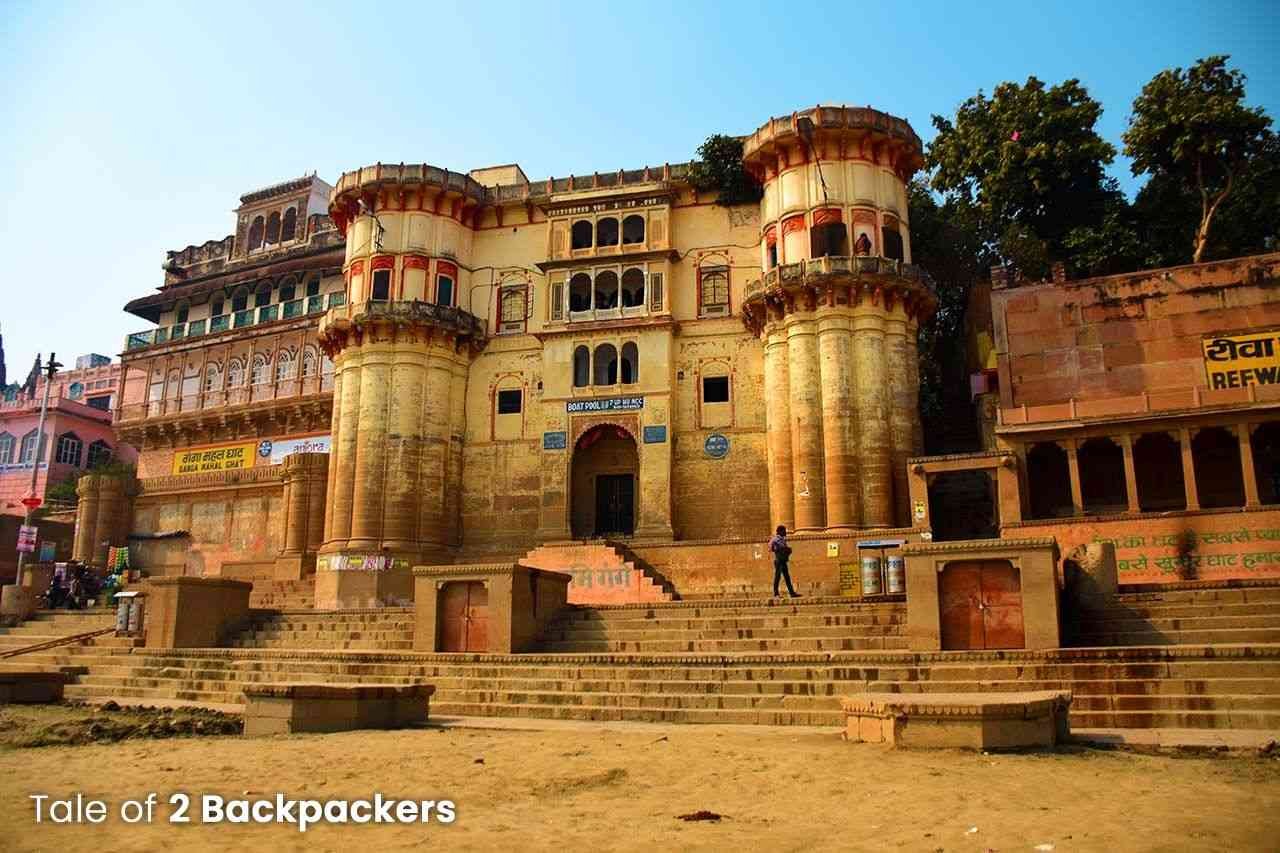
And it was that memory of Varanasi that stayed. Varanasi at that time was dirty and congested, with cow dung on road. The Varanasi Ghats or riverfronts bore the sign of the cycle of life and death that played every day beside the holy Ganges River. After all, Varanasi is one of the oldest continuingly inhabited cities in the world. Varanasi is one of the holiest cities for the Hindus, the city of enlightenment. As per Hindu Shashtra (religious texts), dying at Kashi or Varanasi will give you Nirvana. Every day hundreds of dead bodies are burnt at the Varanasi Ghats, keeping the faith of the people alive.
The Ganges or Ganga, the patron river of the city bears testimony to this cycle of life and death every passing day. Ganga is considered to be the holiest river in India. A dip in the river guarantees a good life, absolution from sins and attainment of nirvana. The river thus washes away all the dirt and filth of the mankind figuratively as well as literally. Ganga has been carrying a huge amount of flower waste, religious leftovers, dead bodies, flotsam as well as industrial wastes for a long time. The water of the holy river in Varanasi where hundreds of people take a dip every day had become toxic. It is sad, that at one hand we consider the river to be our mother and a deity; on the other hand, we do not give a damn about its sustenance.
A few years back, there was alarming news that the Ganga at Varanasi is choking and dying. This sent the environmentalists and the government into thinking and soon after various programmes were undertaken by the government for revival of the river. The work of desilting and cleansing the river and the Varanasi Ghats started. Funds were allocated for making Varanasi cleaner and restoring the river to her old glory. Today, Varanasi is much cleaner, the Ganga has recovered some of her sheen and the Ghats in Varanasi are more beautiful than ever.
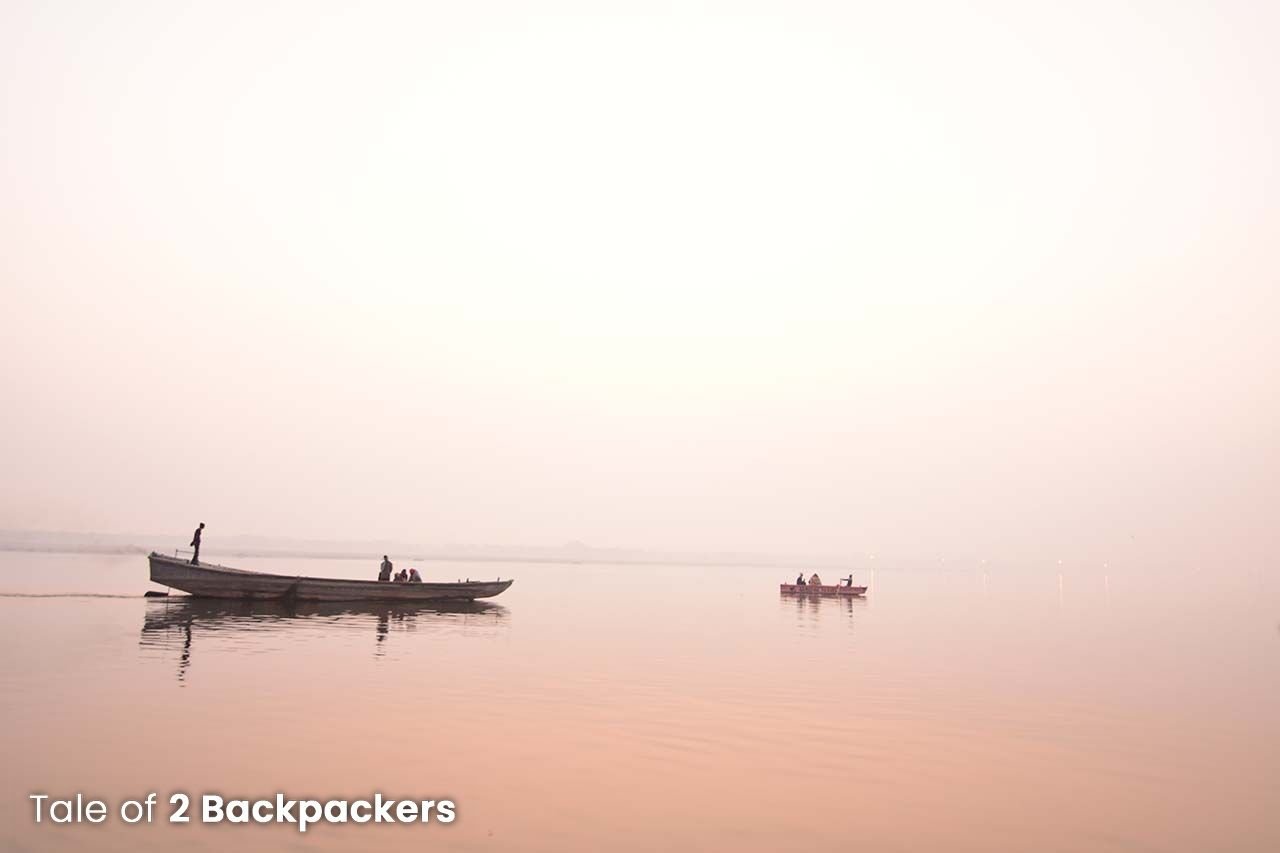
Well, my memory of Varanasi had been of the previous one – a seemingly dirty and congested town that most of the temple towns in India are known for. When Agni and I planned to visit Varanasi again after the Kumbha Mela in 2018, I had not expected much. But I was in for a pleasant surprise. This Varanasi I visited was a tad bit different from my memories. Yes, the alleys are there, the roads till reeked of the smell of dung, death is still a celebration and Varanasi is as overwhelming as it was before. Only the city was cleaner.
The Varanasi Ghats looked beautiful and clean, the Ganga is cleaned and the people seem to be more responsible towards a cleaner Varanasi. Even the evening Arti at the ghats spoke of a cleaner Ganga and Varanasi. It was a welcome change and it made us happy. In the Varanasi trip, the majority of our time was spent on the ghats.
The entire Varanasi can be seen in the ghats. The ghats had different characteristics at each time of the day. It is so true that the entire cycle of life and death is played on the Ghats of Varanasi.
Contents
Ghats in Varanasi
There are as many as 87 Varanasi Ghats. For those who are unfamiliar with the term “ghats”, they are actually riverfronts or embankments leading to the river Ganga. While some of them are quite busy like the Dashashwamedh Ghat and Manikarnika Ghat, there are many that see much lesser footfalls. It is in these ghats where we would sit for hours and watch Varanasi come alive before us.
DO YOU LOVE QUOTES? HERE ARE SOME BEAUTIFUL QUOTES ON VARANASI THAT DESCRIBES THE SPIRIT OF THE CITY SO WELL.
Many of these ghats what we see today were rebuilt in the 1700s by the Marathas, Bhonsles, Scindhias and Holkars. They were again renovated and beautified in recent times by the government. Most of these Varanasi Ghats are associated with mythology and legends. You will invariably see a number of boats tied to the ghats all around the day. The boatman will want you to take for a boat ride on the Ganga. The sunrise and sunset boat rides are quite famous in Varanasi. Infact a visit to the ghats is one of the best things to do in Varanasi.

The most famous Ghats in Varanasi & their significance
While there are so many Varanasi Ghats, some of them are more famous than the others. Some of the ghats are used for pujas and religious ceremonies, some are burning ghats and there are a few private ones too. If you want to see all the 87 ghats in a day, it can become quite hectic. But a good way to get a view of these ghats is on a boat. But here also, most of the boatmen will take you along the most prominent ghats of Varanasi. Here I am listing a few of our favourite Varanasi Ghats along with a few important ones.
-
Dashashwamedh Ghat
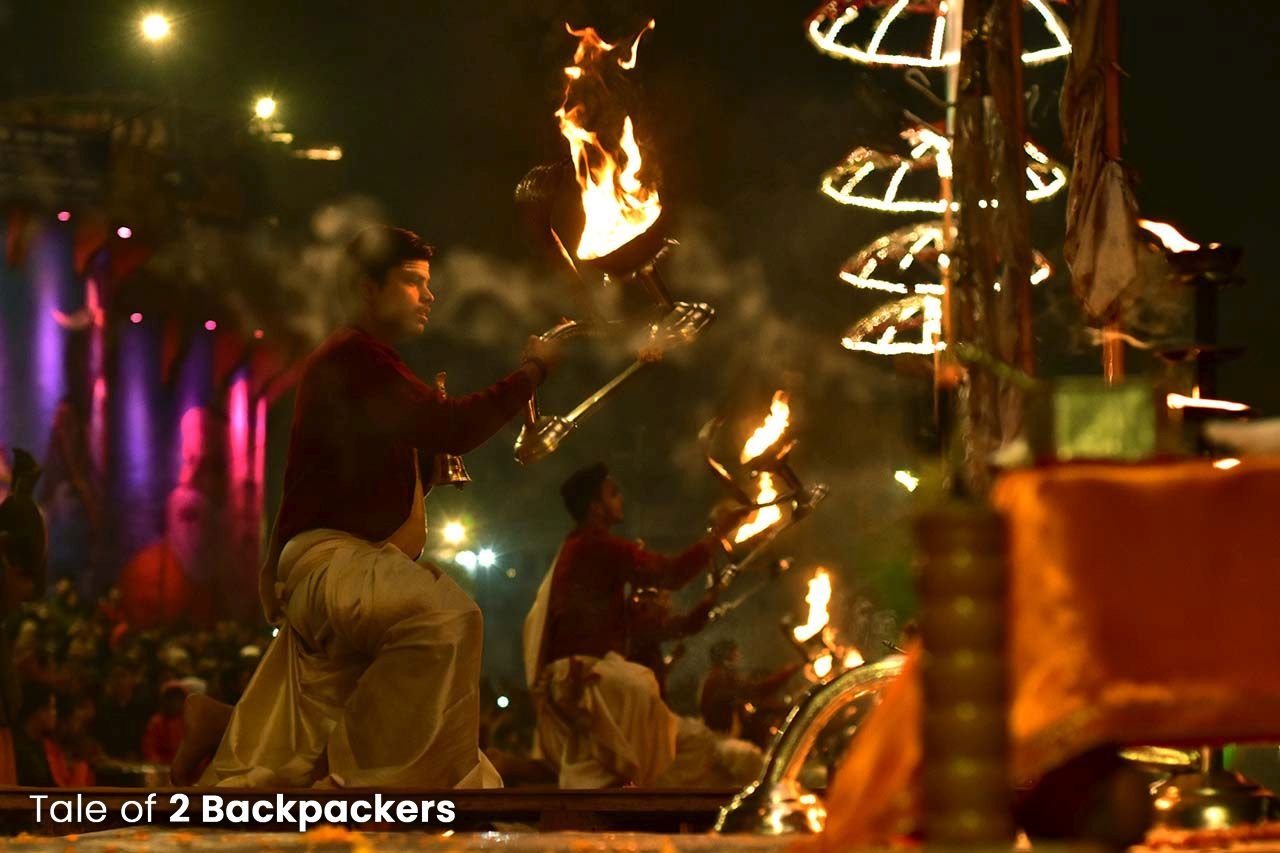
Dashashwamedh Ghat is perhaps the most important Varanasi Ghats. The busiest one and also considered to be the most auspicious one, Dashshwamedh is also the nearest one to the Kashi Vishwanath Temple. Mythologically, it is believed that Lord Brahma performed Ashwamedh Yagna and sacrificed 10 horses for the ritual. That is why the ghat is named so from Dash meaning 10 and ashwa meaning horse.
Dashashwamedh Ghat is always busy. In the day time, you will see hundreds of people on the ghat doing pooja. The big umbrellas are placed under which the pandits and purohits (learned men who know the religious scriptures) sit and chant the mantras and hymns. Men and women with folded hands sit before them doing puja. It is a different world there.
Dashashwamedh Ghat is also known for the evening Arti of Varanasi. The Ganga Arti of Varanasi might be a touristy thing but is also quite spectacular. The Arti is dedicated to River Ganga, Surya – the setting sun, Agni – the fire and Lord Shiva. The entire ghat is full of people during the Arti. Even the boats in front of the ghat are full of people.
Dashashwamedh Ghat is just like a motion picture. From morning to night, the ghat is busy with people doing various things. Some are looking for peace while others are in search of spirituality. And in the middle of all the humdrum, there are some unscrupulous people looking for opportunities to take advantage of gullible tourists. Sit there for some time and you will see it all.
-
Assi Ghat
Assi Ghat is the southernmost ghat in Varanasi. Named after the Assi River, Assi Ghat is just the opposite of the crowded and boisterous Dashashwamedh Ghat. Assi Ghat and the area around it is the place where most of the students, long term tourists and foreign tourists prefer to stay. BHU is quite near and the place is comparatively peaceful that the area near the Dashaswamedh Ghat and Kashi Vishwanath Temple.
Assi Ghat also has its share of mythology. It is believed that Goddess Durga after killing the demon brothers Shumbha-Nishumbha and threw down her sword at the Assi stream. Here the River Ganga meanders and meets with the Assi River.
Assi Ghat is described as “Saimbeda Tirtha” meaning that one who dips in the Ganga here once in his lifetime will get the blessings of all the Hindu Tirthas. Generally, Hindu pilgrims flock here to take a dip in the holy waters of Ganga in the month of Magh and Chaitra (sometime between January and April).
Assi Ghat is also famous for the morning Aarti known as the Subah-e-Banaras. It occurs every day before dawn when beautiful songs are sung, hymns are chanted and a morning Aarti is held venerating the rising sun. The morning Aarti at Assi Ghat is one of the best things that you would see in Varanasi.
-
Manikarnika Ghat

Manikarnika Ghat is the main cremation ghat in Varanasi. It also happens to be one of the oldest and sacred Varanasi Ghats. Like most of the famous Varanasi Ghats, Manikarnika Ghat is also full of stories and legends.
Legend has it that at the beginning of Satya Yug, Lord Vishnu prayed to Lord Shiva at Anand Vana (Kashi) for a long time so that Lord Shiva does not destroy Kashi while he destroyed the world. Lord Shiva was pleased by the earnest request of Lord Vishnu and gave the boon of eternal peace to Kashi. Lord Vishnu with his Sudarshan Chakra dug a pond or Kund at the place for Lord Shiva and Goddess Parvati. While having a bath in the Kund, a Mani (jewel) from his earring fell into the pond. Hence the Ghat was named Manikarnika Ghat. Some other school of thoughts also believe that the earring of Sati fell at this place after she gave up her life.
Lord Shiva granted that the place would be the holiest of all the places. If the last rites of any person are performed at Manikarnika Ghat in Kashi, then the person’s soul attains Moksha and he/she is liberated from the cycle of birth and death. So at Manikarnika Ghat, you can see death very closely. The ghat itself is congested and bit unclean. The access from the road to the ghat is full of shops selling wood. You can also see boats laden with wood near the ghat.
Kashi is one place where death is also celebrated. We have seen dead bodies brought to the Manikarnika Ghat in huge processions amidst playing drums and trumpets. The dead bodies are brought wrapped in glittering clothes and then their last rites are performed. The entire scene can become graphic for many who are not accustomed to the Hindu rituals of burning bodies. So we would suggest that if it gets too much for you, it is better to stay away.
PS: Manikarnika Ghat is one of the places where foreign tourists can be scammed by the infamous burning wood scam of Varanasi. So be wary of people who would approach you with their sad tales and ask you money for buying wood for the dead!
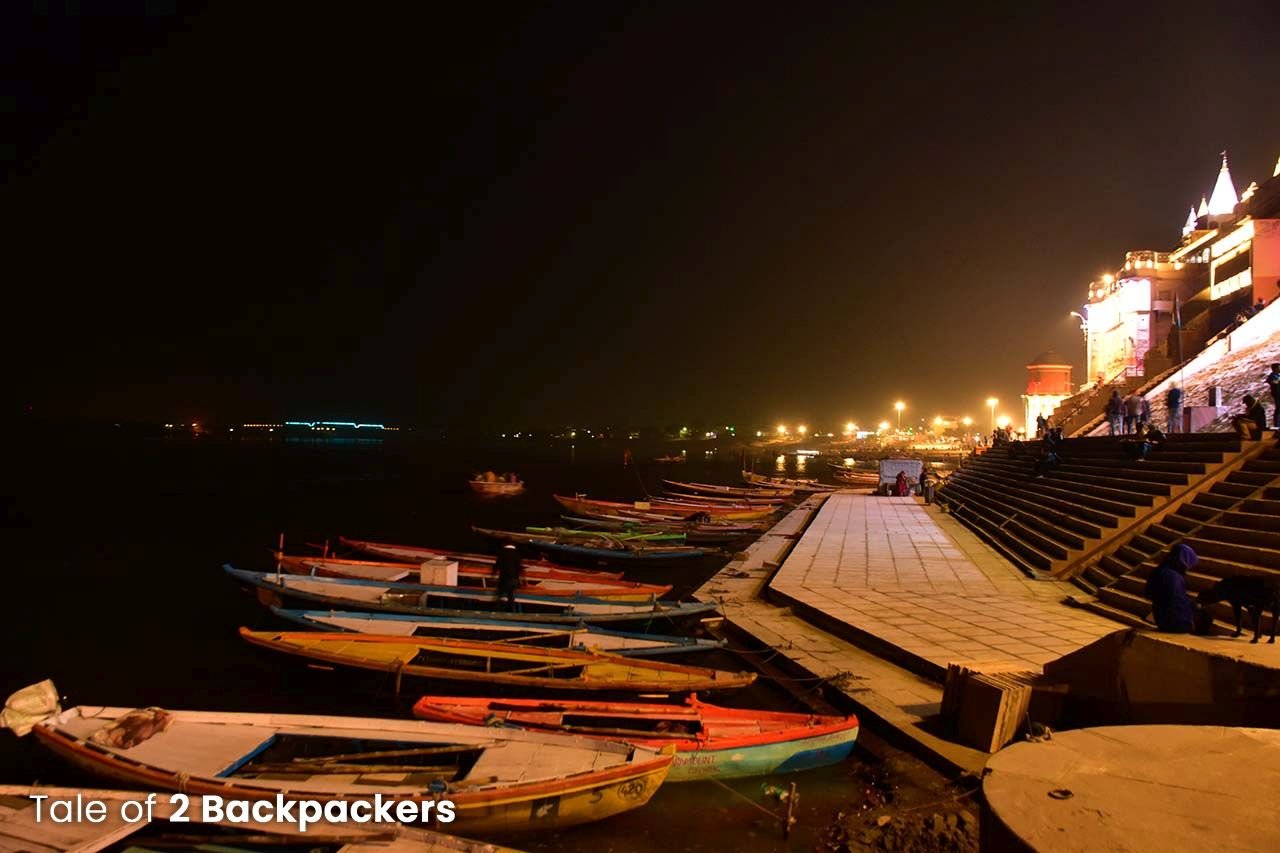
-
Raja Harishchandra Ghat
Harishchandra Ghat is the other ghat in Varanasi where the cremation takes place. This is also one of the oldest Varanasi Ghats having a strong mythological connect. It is said the Raja Harishchandra, the righteous and honest king who only spoke truth served at the ghat as a ‘dom’ (the person who cremates the dead bodies).
It is believed that cremation in Harishchandra Ghat had been taking place even before than Manikarnika Ghat. We cannot vouch for the fact. History, myth and tales are all intertwined in Varanasi. And it was quite overwhelming as well as interesting to know about these stories as we walked from one ghat to the other.
The doms at the ghat are the keeper of the sacred fire that is never allowed to die down. You can see the sacred flame lighted at the Harishchandra ghat. The Dom Raja is responsible for the flame to be always burning. The first fire to light the funeral pyre is taken from this eternal sacred fire.
Harishchandra Ghat, just like the Manikarnika Ghat is quite a powerful place. You can always see at least three or four pyres burning at the ghats all through day and night. It is estimated that at least 800 cremations take place in Varanasi everyday! The ghat can be crowded, chaotic and dirty at times. But remember, this is the faith of a large number of people. If you do not like to see it, stay away from it.
-
Chet Singh Ghat
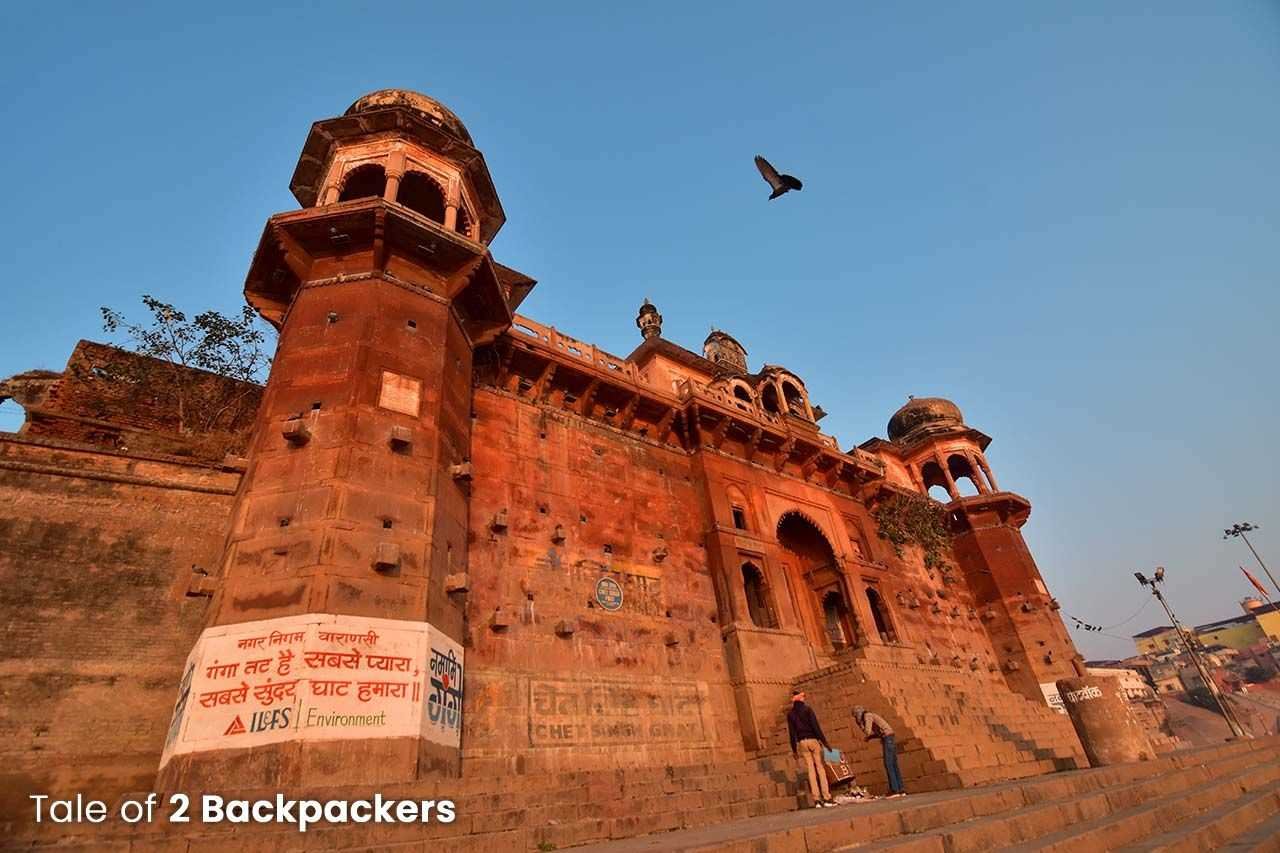
Chet Singh Ghat is one of our favourite Varanasi Ghats. An imposing fortress dominates the ghat built by Maharaja Chet Singh in the mid-eighteenth century. The fort was his primary residence. The place witnessed a fierce battle between troops of Warren Hastings and Maharaja Chet Singh in 1781. The Maharaja lost the battle to the British, but it is said that he escaped from the fort and the fortress went under the control of the British.
Later in the 19th century, the possession of the fort was taken by King Prabhunarayan Singh. Later the northern part of the fort was donated to the Naga Sanyasis, a group of ascetics known for their harsh way of living. They had built a temple and accommodation at that place.
-
Darbhanga Ghat

Darbhanga Ghat is one of the popular Varanasi Ghats where you can see the 18th century built Brijrama Palace overlooking the Ganges. This is one of the oldest forts to be built on the riverfront by the royal family of Nagpur. The fort was later acquired by the Maharaja of Darbhanga, Rameshwar Singh Bahadur in the 20th century.
The Maharaja of Darbhanga renovated the fort and installed the first-ever elevator in South Asia. Today the Brijrama Palace is converted into a boutique hotel and the elevator is used to carry guests inside the property. The palace turned hotel provides a luxurious stay amidst the busy ghats. The pink coloured building looks beautiful in the morning sun.
-
Scindhia Ghat
Scindhia Ghat is located just beside the Manikarnika Ghat. What is interesting here is the submerged temple dedicated to Lord Shiva. The temple collapsed during the construction of the ghat in 1870. The Ghat is named after the Scindhia who were the patrons for building the ghat. Behind the Scindhia Ghat, there is a narrow maze of alleys having a lot of old temples. The place is known as “Siddha Ksetra” or the land of fulfilment.
It is believed that Agni, the Fire God of the Hindus (and not my partner Agni!) was born here.
-
Ahilyabai Ghat
Ahilyabai Ghat has the distinction of being the first ghat to be named in honour of a person, Queen Ahilyabai Holkar of Indore. The ghat was earlier known as Kevalagiri Ghat. In between 1778-1785, under the patronage of Queen Ahilyabai, the ghat was completely renovated. There is a residential palace and a few temples in the ghat.
Apparently, the palaces and temples cannot be ascertained from a distance. You cannot fathom from a first look that the beyond the ghat there is another world. And this is true for most of the Varanasi Ghats.
-
Anandamayi Ghat
The ghat was earlier known as Imalia Ghat. In 1944 Mata Anadamayi purchased this ghat from the British and built an ashram for her devotees. You can still see the Anadamayee Ashram at the upper part of the ghat.
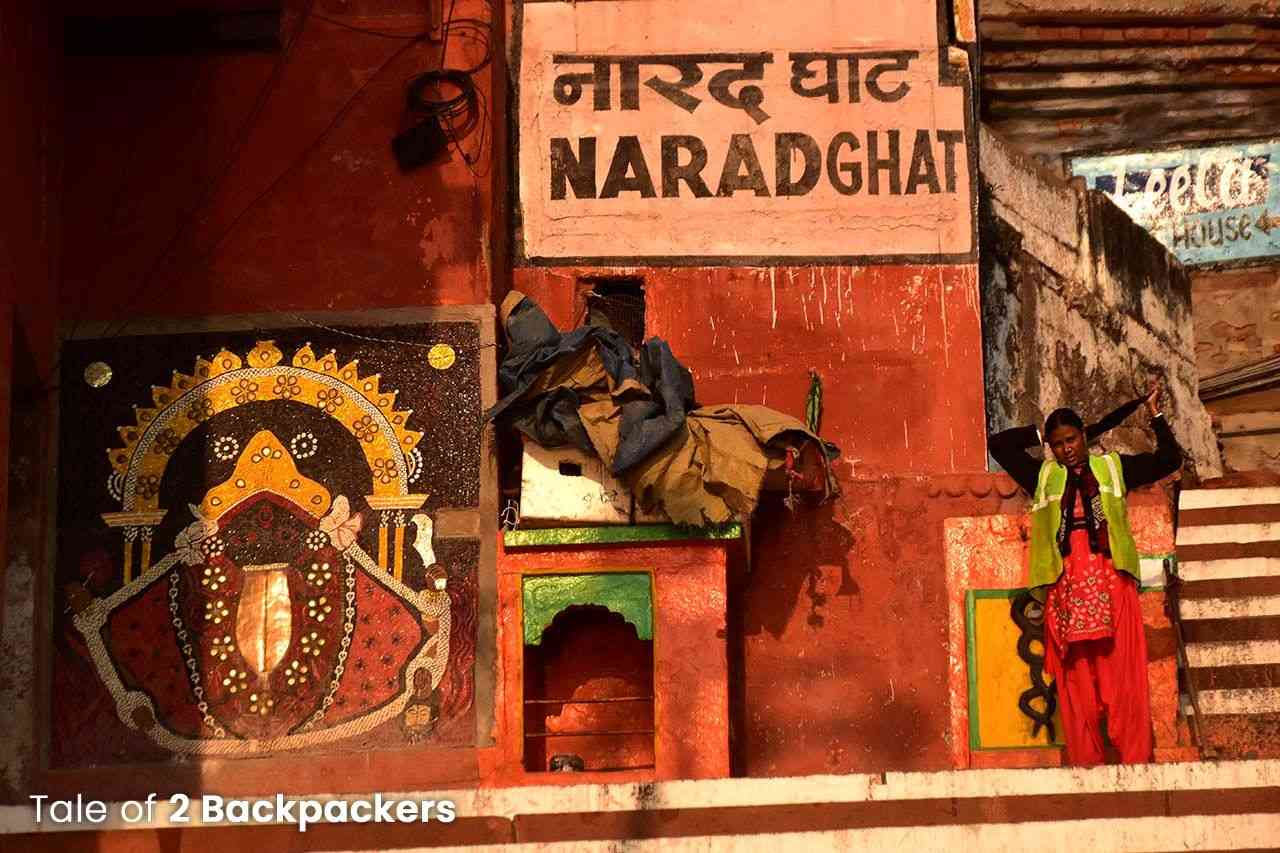
-
Babua Pande Ghat
I have mentioned the Pande Ghat because this is one of the most colourful ghats that I found in Varanasi, not because of any colourful wall art or structure, but for the colourful clothes that are hanged there for drying.
This ghat was made pucca in the 19th century by Kavindra Narayan Singh. In 1805 Babua Pande, a rich Brahmin of Chhapra (Bihar) had built a wrestling place near the ghat and so the ghat was named after him.
Whenever we go by the Pande Ghat, we had seen people washing clothes and a large number of clothes of different colours are hanged there to dry. This might be the ghat for the washermen.
-
Tulsi Ghat
Tulsi Ghat is named after the 16th century famous Hindu poet Tulsi Das. It is believed that it was at this place where Tulsi Das composed the Awadhi version of the holy epic poem ‘Ramcharitamanas’.
For us, Tulsi Ghat was a place of peace and solitude. We loved the vibe of the ghat and would sit here and at the adjacent Rewa Ghat for hours talking among ourselves and looking at the Ganga. We do not usually get time to talk with each other without thinking about the worldly duties of life.
Tulsi Ghat is also known for the Akhara or the wrestling ground. You can visit the Tulsi Ghat Akhara in the morning around 7 AM to see the wrestlers practice.
The Lolark Kund is also near the Tulsi Ghat.
-
Bhonsle Ghat
Bhonsle Ghat is owned by the Maratha King Bhonsle from Nagpur in 1780. This ghat also has a construction looking like a gateway. There are three important shrines near this ghat – the Laxminarayan Temple, the Raghurajesvara Temple and the Yamaditya Temple (dedicated to the Lord of death, Yama).
Just beside the Bhosle Ghat is the Guleria Kothi, another very beautiful heritage and boutique property in Varanasi.
-
Jain Ghat
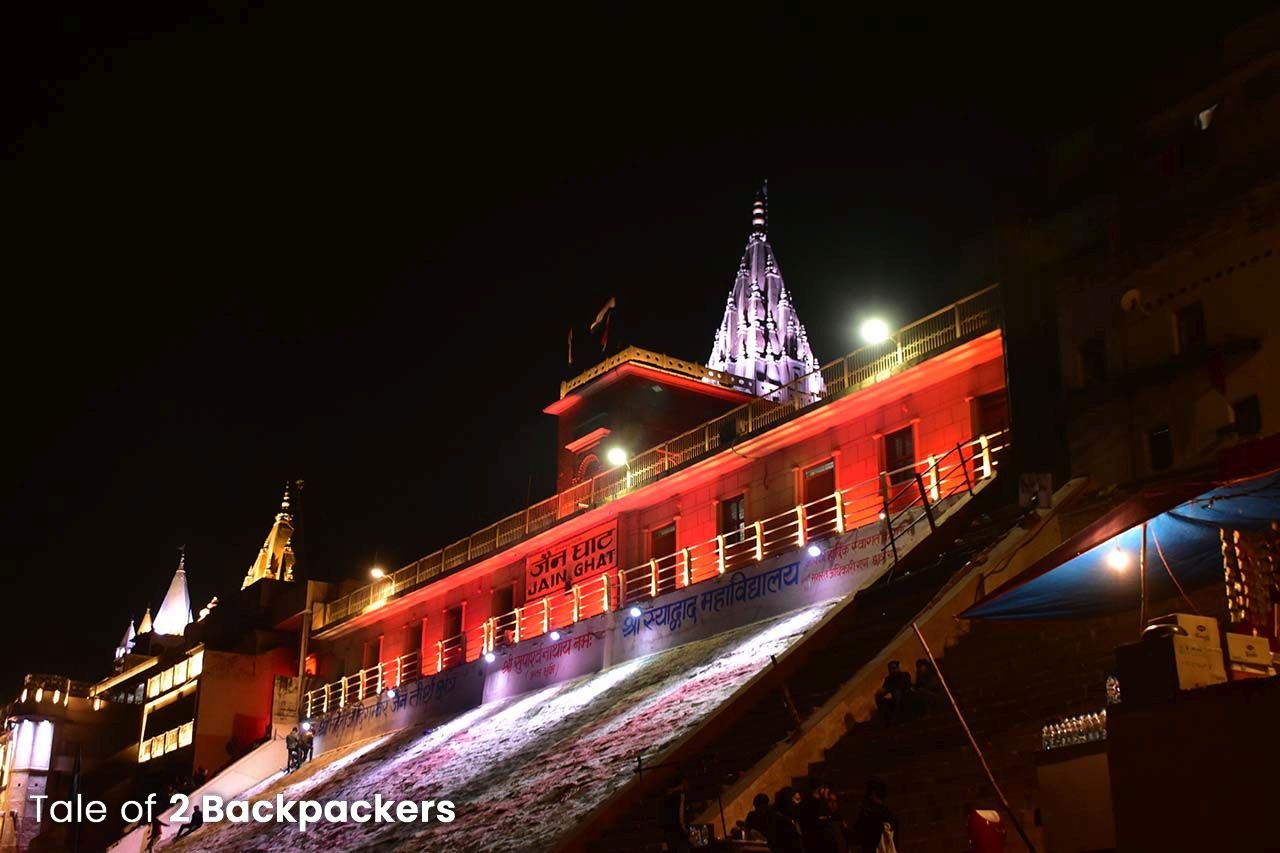
Jain Ghat has some beautiful white coloured Jain temples. During the night, the ghat looks spectacular as it is lighted up with coloured lights. The ghat was earlier known as the Vaccharaja ghat, but later Babu Shekhar Chanda had rebuilt the ghat and named it after the Jain Tirthankara. It is believed that the 7th Jain Tirthankara, Suparshvanatha was born in the neighbouring area.
The Jain Ghat is a good place to sit idle on the stairs and spend time looking at the river in front. The ghat is relatively less crowded and you can there for hours as you see the different people pass by.
-
Man Sarovar Ghat

Man Sarovar Ghat was built by Raja Man Singh of Amber, Jaipur in 1585. The King had also added a pool nearby that is known as the Mansarovar Kund. It is believed that the water of the pool is as sacred and pious as that of the sacred Mansarovar Lake in Tibet. Now with more and more construction coming up, the Kund (pond) has become a Kupa (well) and is known as Mansarovar Kupa.
The Kumarswamy Mutt is located in the upper parts of the Mansarovar Ghat.
-
Rajendra Prasad Ghat

Rajendra Prasad Ghat was initially the part of the Dashashwamedh Ghat. Later this was named such in honour of the first president of India, Dr Rajendra Prasad.
Everyday, evening aarti is also held at Rajendra Prasad Ghat along with Dashashwamedh Ghat. And both the ghats get an equal amount of crowd.
-
Kedar Ghat

Kedar Ghat is another important ghat in Varanasi. It has a very colourful Dravidian type temple on the banks. The Kedar Ghat has a temple dedicated to Lord Shiva and is quite famous among South Indian pilgrims. The ghat was built by the Vijayanagar King.
You will see the maximum number of pilgrims from the Southern part of India at Kedar Ghat and Vijayangram Ghat. These two ghats are quite busy and are always full of people offering prayers, doing various rituals and others.
There is a pool nearby known as the Gauri Kund. The water which was present there once upon a time was said to have medicinal values.
-
Man Mandir Ghat
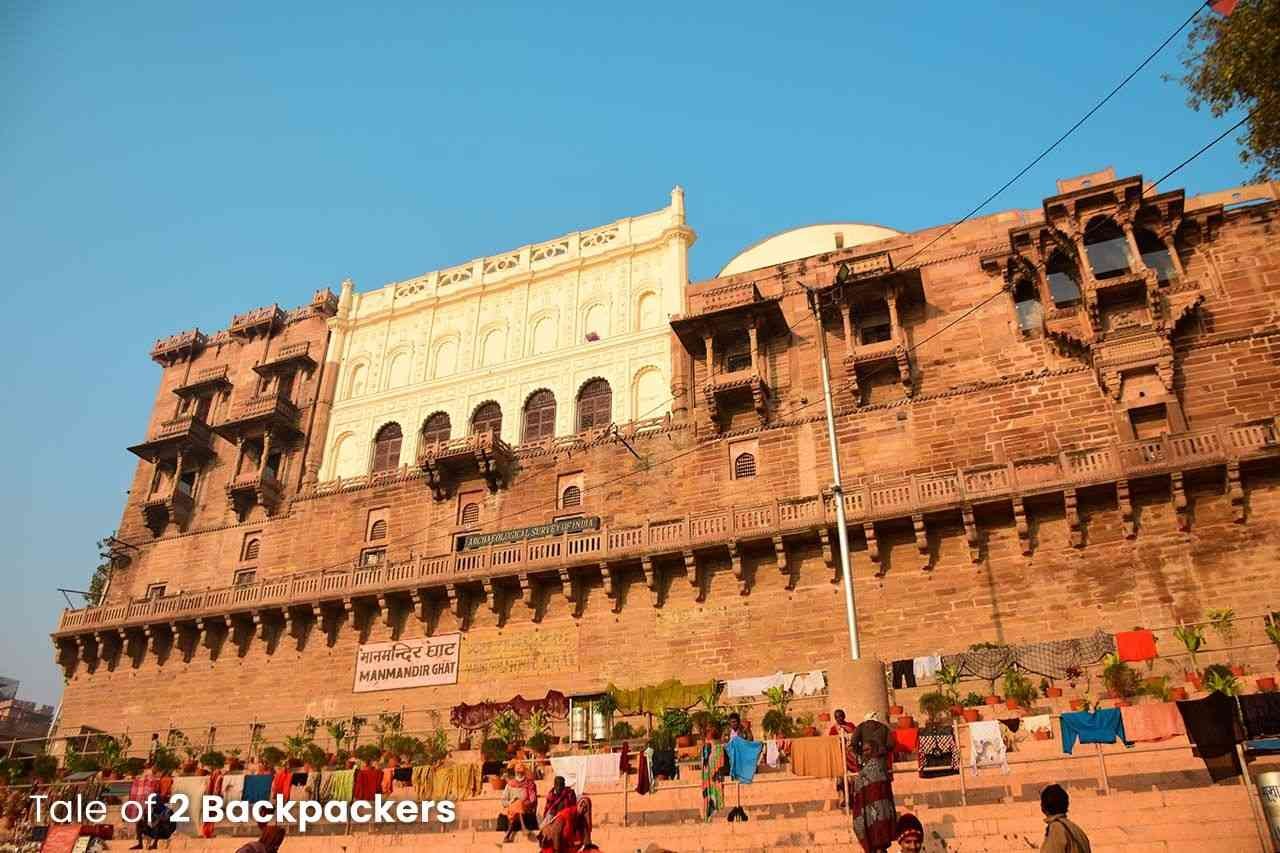
Man Mandir Ghat was built by the King of Amber from Rajasthan. The ghat is known for the magnificent eighteenth-century observatory that was built by King under the instruction of his astrologer. The ghat is also known for its exquisite ornate window carvings.
Located just near the Dashashwamedh Ghat, take a visit to the Man Mandir Observatory when you are there.
-
Nepali Ghat or Lalita Ghat

There is a tiny piece of Nepal right in the midst of India. Lalita Ghat, also known as the Nepali Ghat looks like just any other Varanasi Ghats. But once you climb the stairs, you will come across two-storeyed red coloured terracotta, stone and wood pagoda amidst the many temples dotting the Varanasi skyline.
The King of Nepal, Rana Bahadur Shah had taken exile in Varanasi from 1800 to 1804. During this time, he decided to build an exact replica of the famous Pashupatinath Temple of Nepal in Varanasi. But before the construction of the temple was finished, he went back to Nepal and was later murdered. His son later completed the construction of the temple. The managing body of the temple claims that the temple and its adjoining area and an adjacent dharmashala all belongs to the government of Nepal. He claims to have papers proving the transfer of land by the ruler of Kashi to the Nepali King Rana Bahadur Shah.
Well, whether the land belongs to Nepal or not is not our concern, but the temple itself is really beautiful. The temple has a Nepali architecture style and has beautiful wood carvings. The carvings are said to have been inspired by the sculptures of Khajuraho, and hence the place is also known sometimes known as mini-Khajuraho.
-
Panchganga Ghat

Panchganga Ghat is often missed by most tourists, but this is one of the important Varanasi Ghats. The place is believed to be the confluence of 5 rivers. According to legends, the symbolic rivulets Dhutapapa (one who cleanses the sins) and Kirana (sun’s rays) meet the three major rivers of ancient India Ganga, Yamuna and Saraswati at this place. There is a shrine dedicated to the 5 (Pancha) rivers (Ganga) here.
It is also believed that the great medieval Sufi Saint found his guru Vaidant Ramanand at this place and this was his learning place. Tulsi Das is also said to have composed the famous Vinay Patrika at this ghat.
What impressed us most about the Panchganga Ghat is the imposing Alamgir Mosque right above the ghat. The mosque was constructed by Mughal Emperor Aurangzeb at the site of the Bindu Madhava Temple dedicated to Lord Vishnu. Locally the mosque is known as Beni Madhav-ka-Darera. The Alamgir Mosque is a beautiful mosque overlooking the river. You can climb up the mosque and spend some time there.
-
Gai Ghat
The reference of Gai Ghat can be found in many 17th century texts. There is a huge statue of a cow at the ghat which is also the reason for the name of the ghat (Gai means cow). This is a peaceful ghat and less crowded.
-
Adi Keshava Ghat
Adi Keshava Ghat lies on the outskirts of the city when the Varuna River flows into the Ganga. Just like the Assi Ghat, it marks the border of Varanasi or Kashi. Adi Keshava (meaning the Original Vishnu) is the place where Lord Vishnu first arrived at Kashi as an emissary of Lord Shiva. The ghat is unapproachable during the rainy season. There are a number of Ganesha shrines near this ghat.
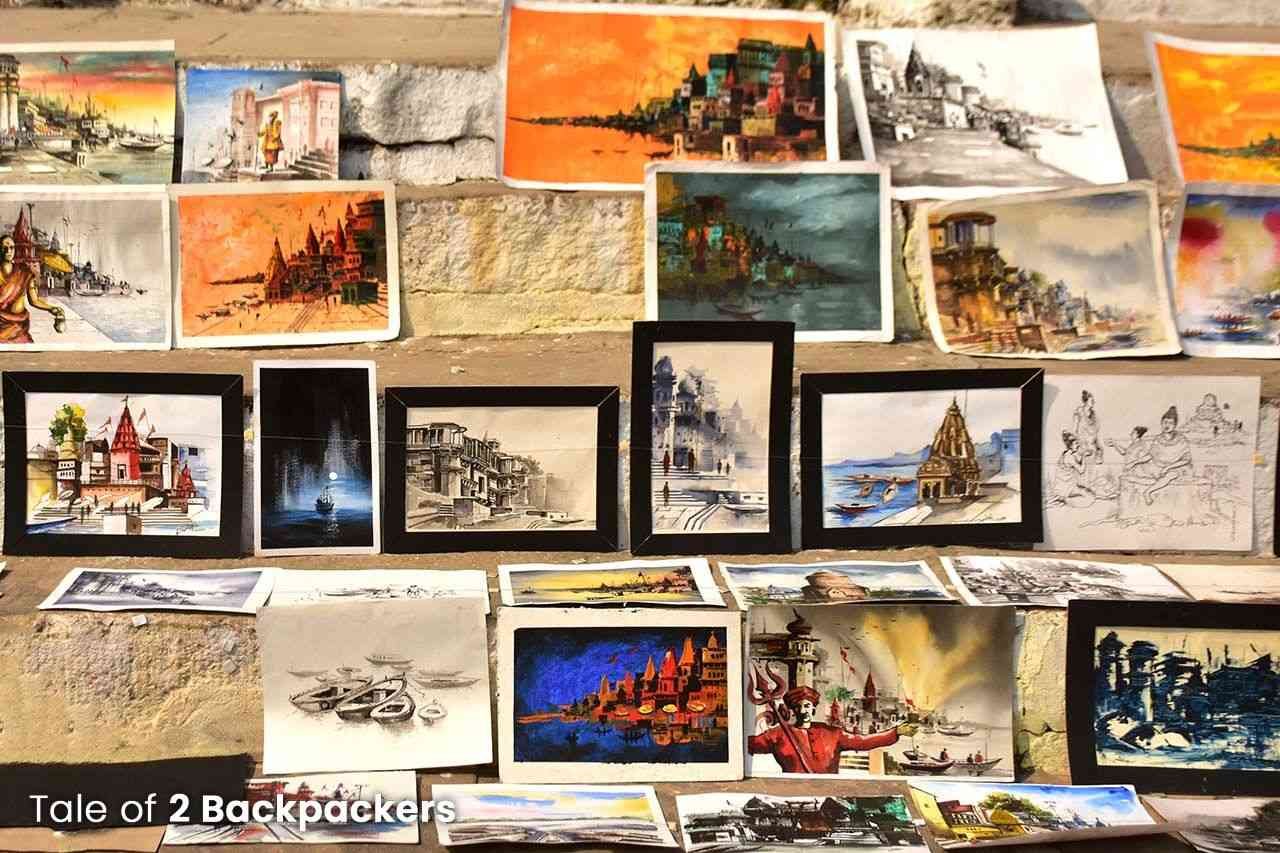
What can you do at the Varanasi Ghats?
While there are 87 Varanasi Ghats and some of the ghats are quite near to each other. Roaming around the Varanasi Ghats is one of the best things that you can do in Varanasi. Take a boat ride and you can get an overview of the ghats from the boat. If you have time then walk along the ghats. It is going to be an enjoyable experience. As I mentioned before, you can see the entire life of Varanasi on the ghats.
-
Watch Subah-e-Varanasi at Assi Ghat
Every morning before sunrise, a cultural programme is held at Assi Ghat where classical songs of mainly Benaras Gharana are sung. An Aarti is also held venerating the sun god and the River Ganga. The morning Aarti at Assi Ghat is one of the best aartis that you will see in Varanasi. In the morning, the aarti sees less crowd than the evening aarti and you can get some really great photographs of the aarti.
Tip: If you want to get good Aarti photograph, attend the morning aarti at Assi Ghat.
-
Watch the evening Ganga Aarti
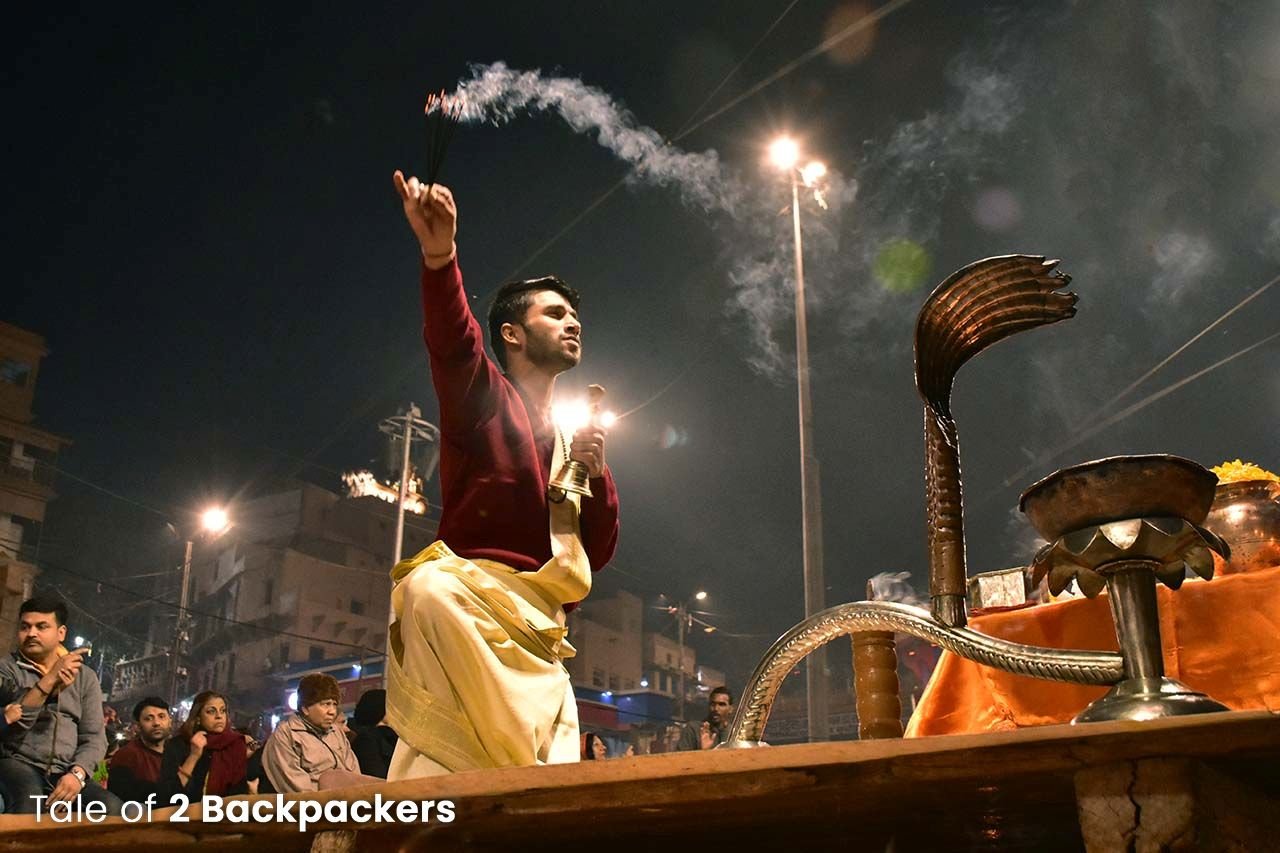
Ganga Arti might be quite touristy, but it is one of the best things to do in Varanasi. Every evening Dashashwamedh Ghat and the Rajendra Prasad Ghat gets a lot of crowds just to watch the aarti. The hymns and songs played at the background. The boats in front of these ghats are also full of people waiting to get a view of the aarti.
Tip for photography: If you have just a camera with a prime lens, then wait for everyone to settle down and take your place at the last. You will get a better position to take photographs. You will not get good photographs from the boat.
-
Take a boat ride on the Ganges

The best way to explore Varanasi ghats is by taking a boat ride. Take a sunrise boat ride or a sunset one or take a ride at any time of the day; it will be a surreal experience.
-
Visit the Akharas
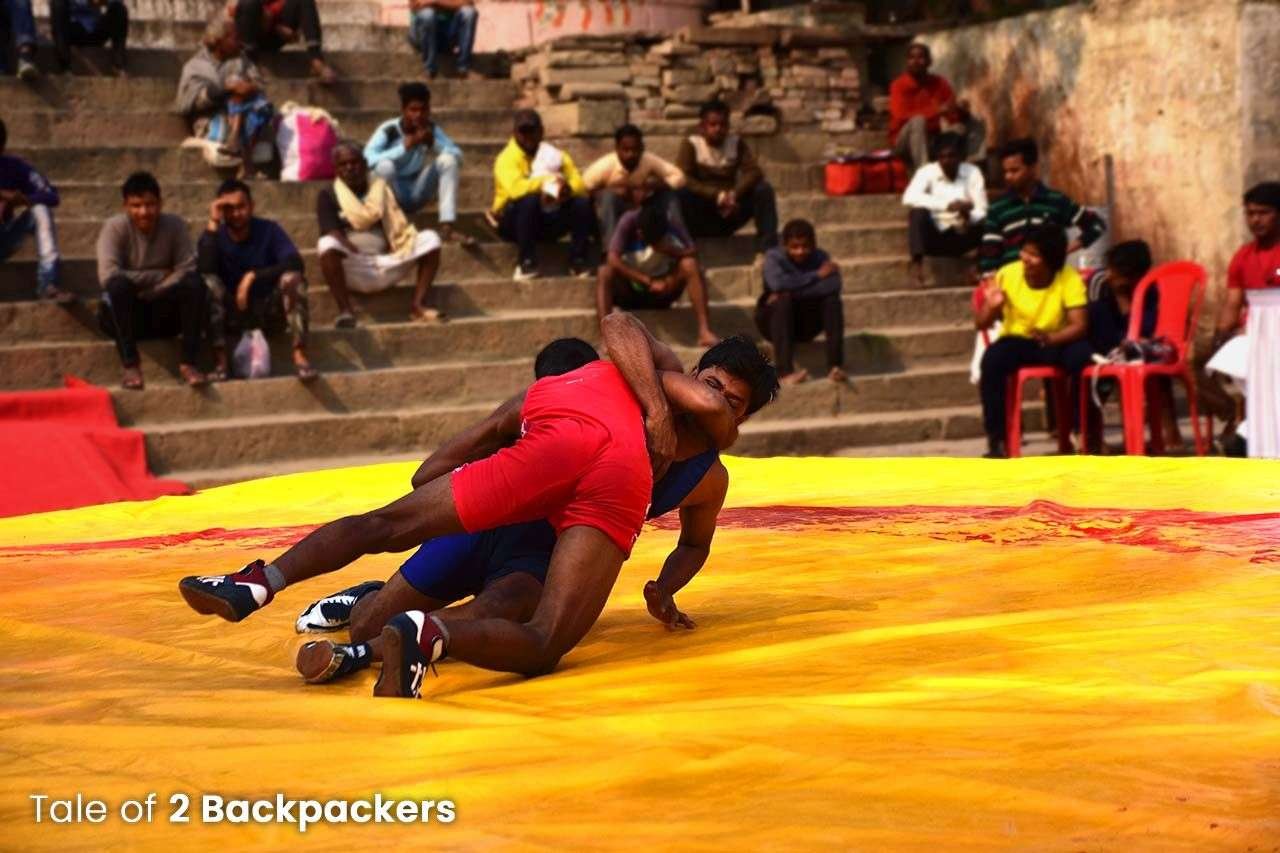
The akharas are places where wrestlers practice. There are a few akharas along the ghats in Varanasi. The most famous one is the Juna Akhara, but usually, tourists are not allowed inside. You can go to the Tulsi Ghat Akhara in the morning around 7 AM and see the wrestlers fight out with one another.
-
Stroll along the Ghats in Varanasi
The best way to experience Varanasi ghats is to walk around. We enjoyed the activity at the Dashaswamedh Ghat and Kedar Ghat while absolutely enjoyed the peace at Assi Ghat, Rewa Ghat and Panchganga Ghat. And while you stroll along the ghats, keep an eye for the wall arts. Some are really beautiful.
If you like wall arts, there are a few after the Bhosle Ghat towards the Panchganga Ghat. We really loved them. And yes, they were extremely instagrammable!
-
Admire the Wall Art at the Ghats in Varanasi
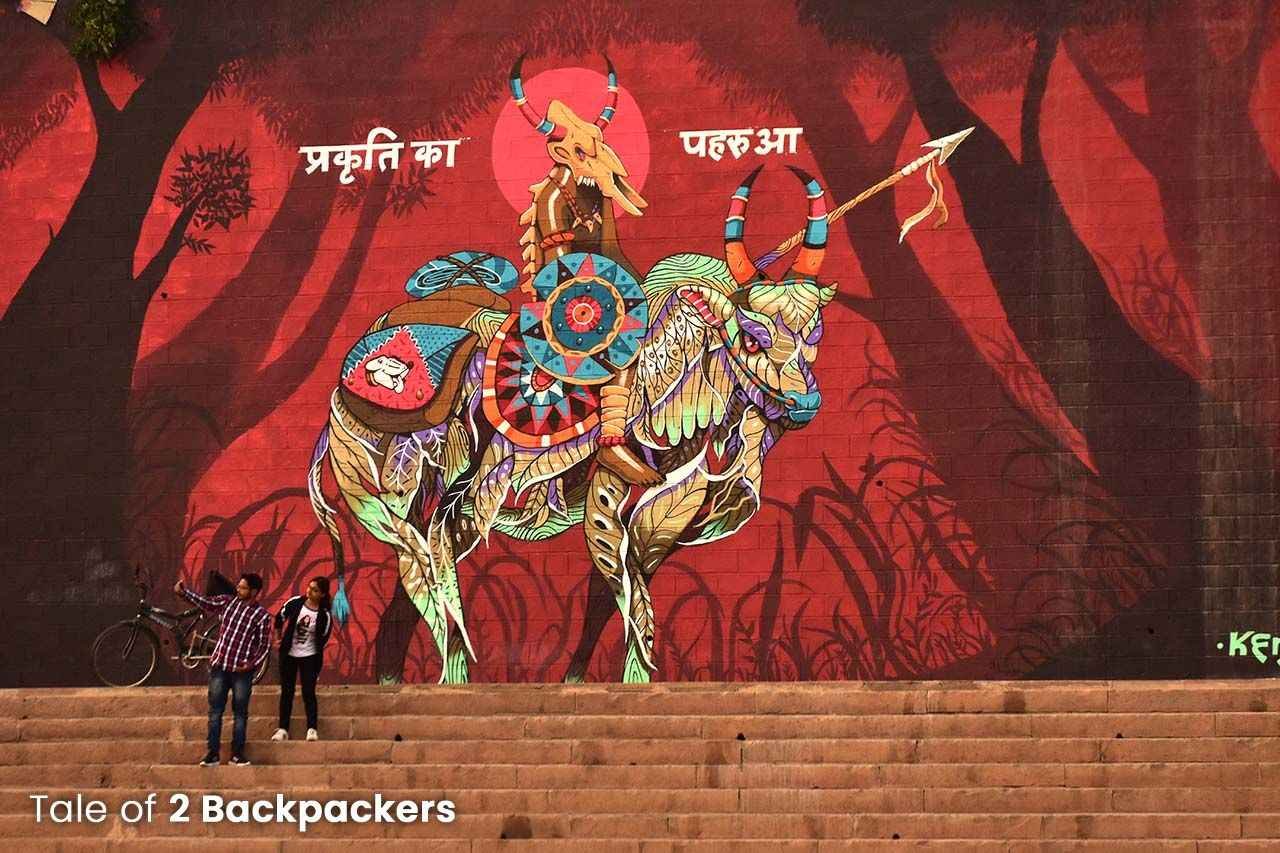
We were pleasantly surprised to see the wall art at the ghats in Varanasi. We heard that there were more, but many of them had been repainted. If you go beyond the Manikarnika Ghat towards Gai Ghat, you will see a number of very vibrant and colourful wall art. There are fishes, cows and many others. Look at the pictures below!
Wall art at the Ghats in Varanasi
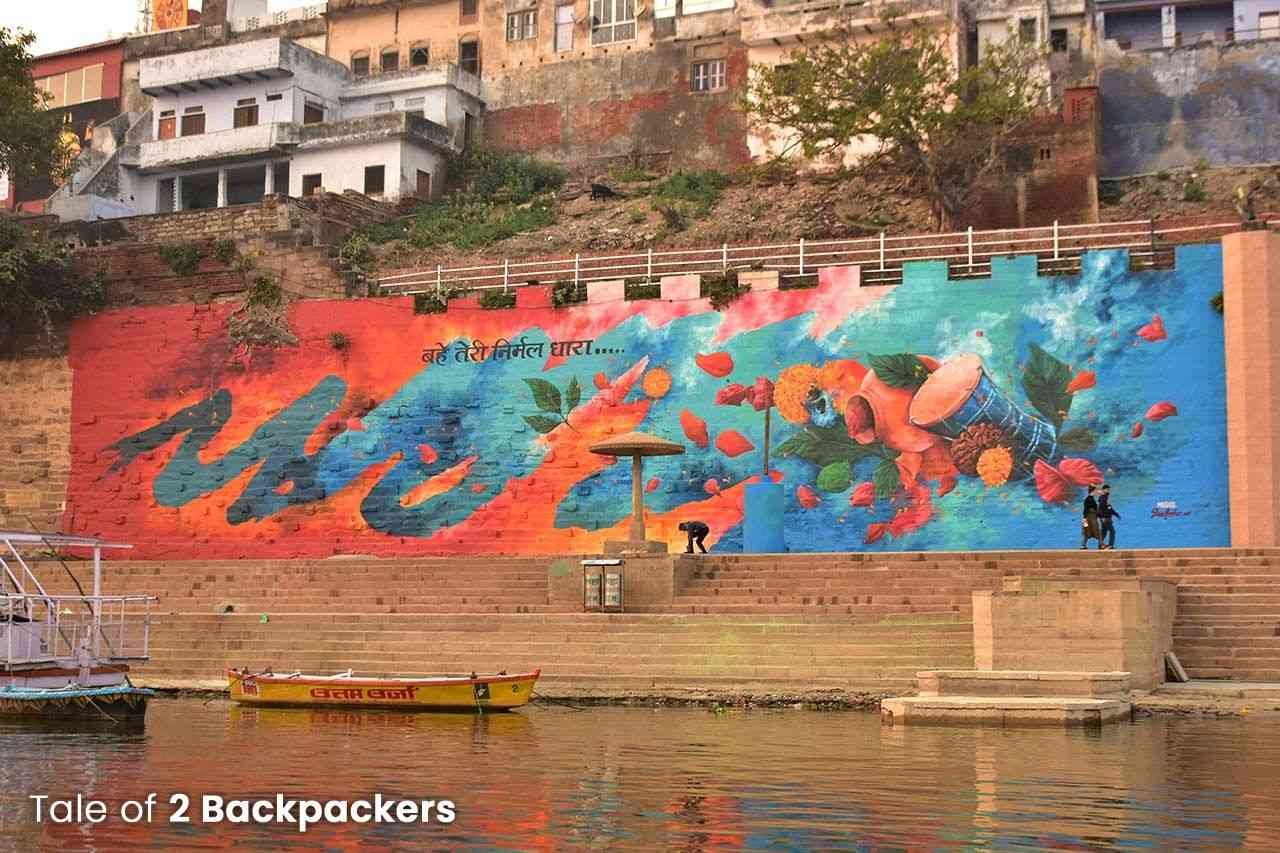
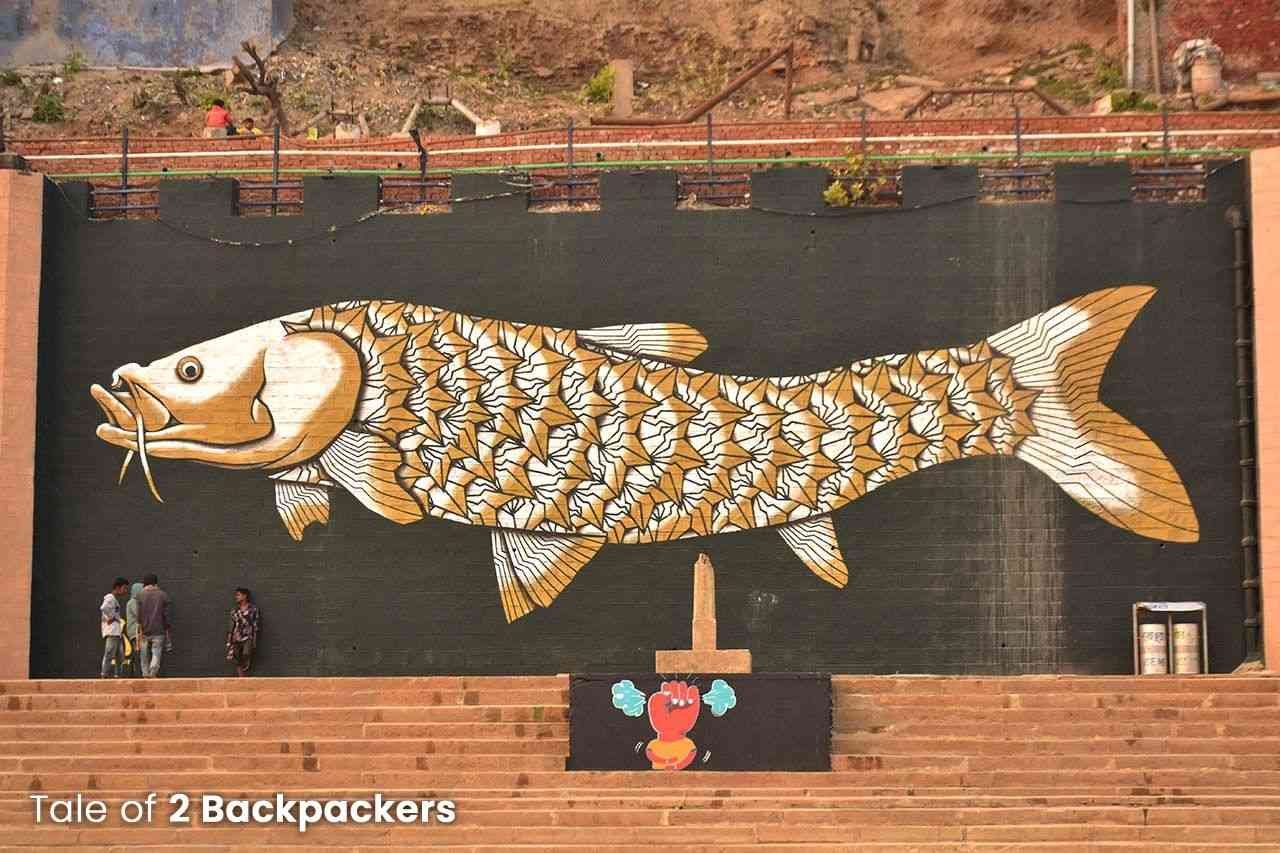

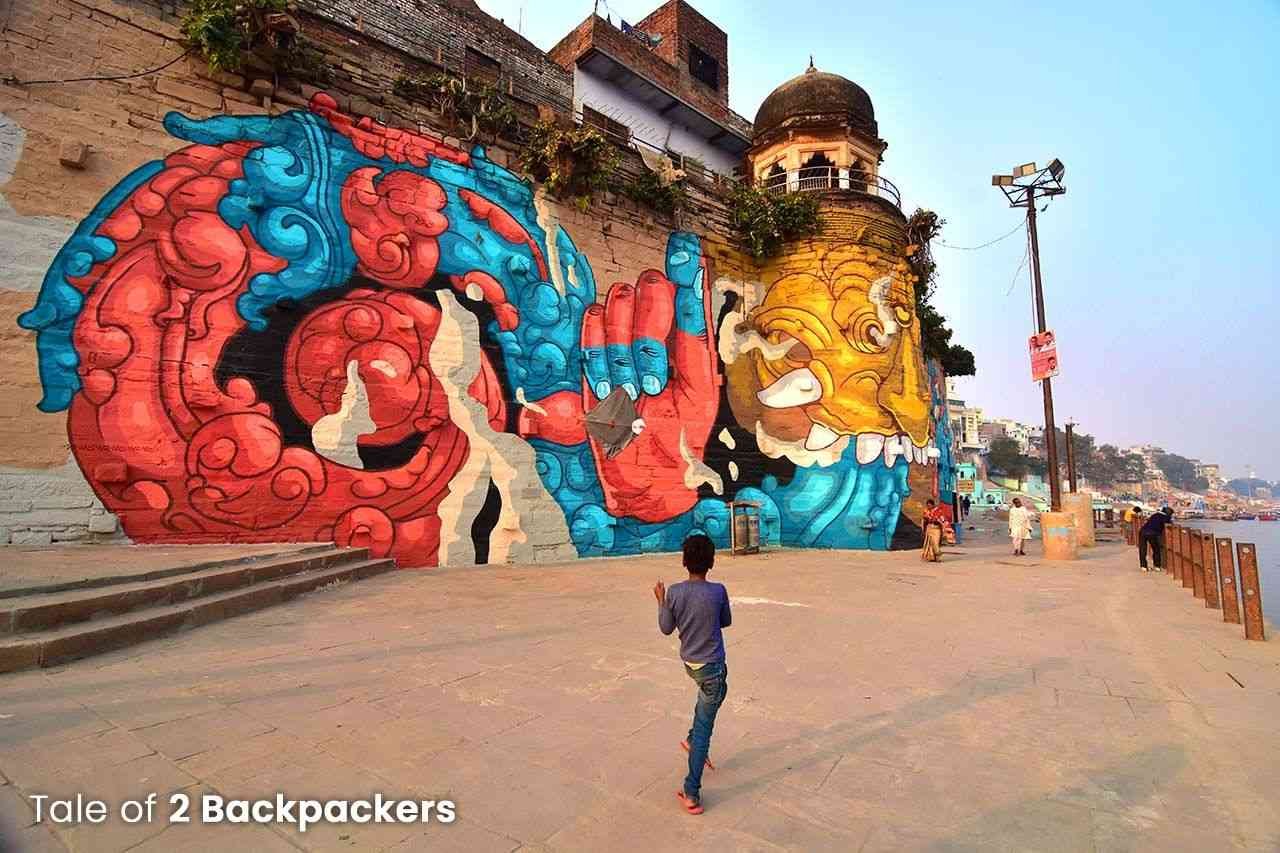
Having Fun!
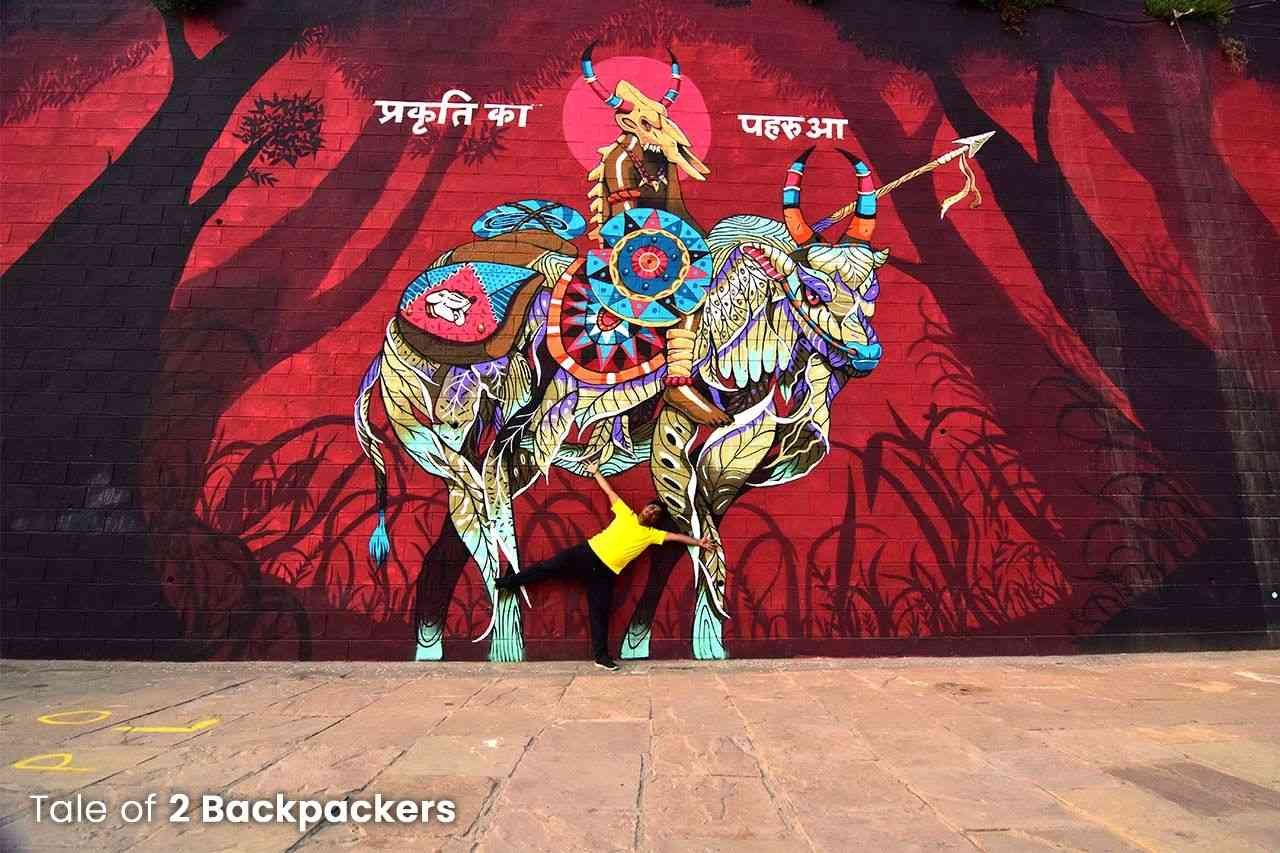
Peek-a-boo!
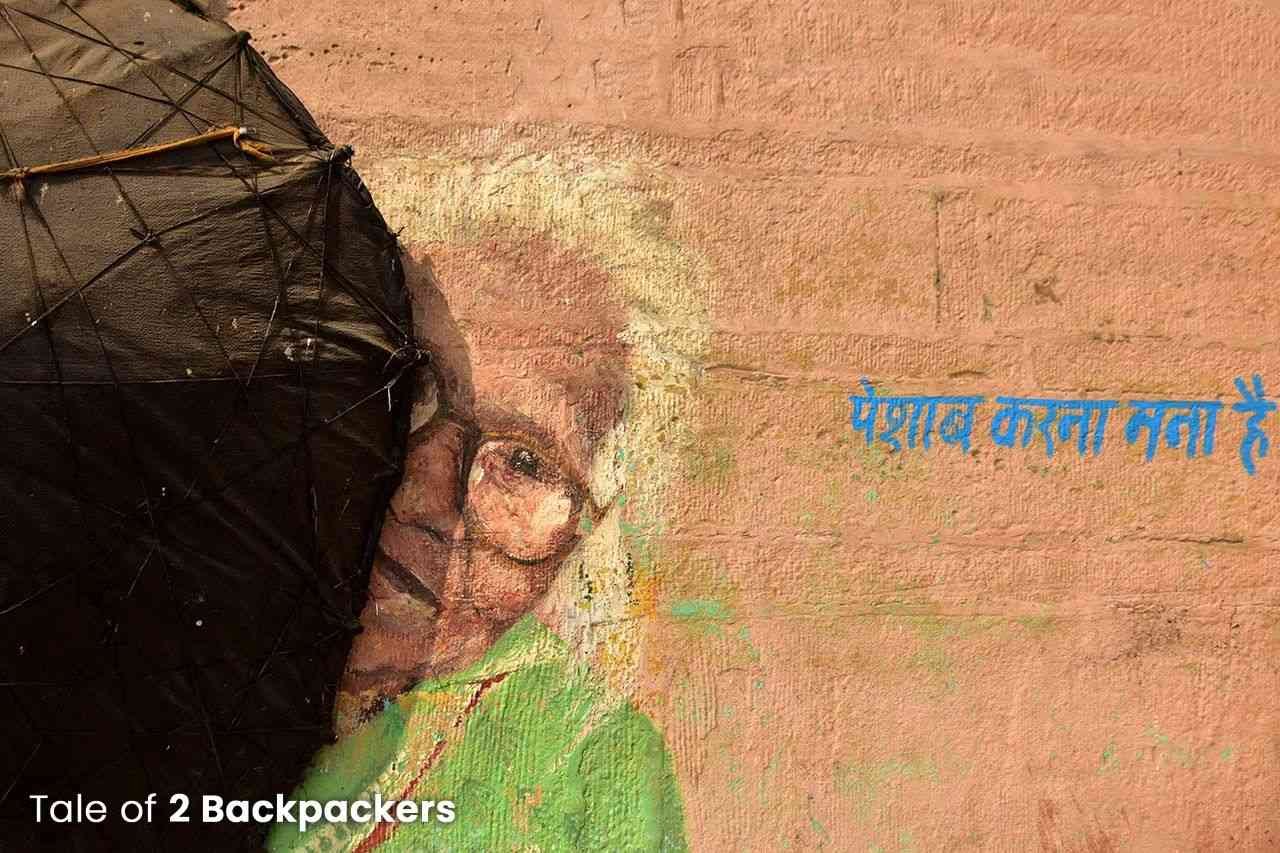
How to explore the Varanasi Ghats?
You can take a boat ride to explore the ghats. You will get boats from almost all the main ghats. The boatmen will themselves approach you. You can start your boat ride from the farthest Assi Ghat and then go up to whichever one you like.
There are shared motorboats usually available from the Dashashwamedh Ghat and Assi Ghat that will take you for a tour of an hour or two. A guide is usually present who tells you about the significance and stories about the ghats. These boats usually cover a fixed number of ghats.

You can also take a private boat just for yourself and ask the boatman to take you to the ghats you fancy. Of course, bargain before you hop on to a boat. You can even ask the boat to stop at some designated ghats. But that would obviously cost more.
Tip: We have noticed that a boat ride costs a bit lesser if taken from Assi Ghat than the Dashashwamedh Ghat or Manikarnika Ghat.
Should I stay near the Varanasi Ghats?
Of course, you can. If you are looking for some boutique experiences, then there are a few heritage hotels along the ghats. Staying at these properties will give you quite an experience.
Otherwise, plenty of hotels and guest houses are also available along the ghats. Whether you will get a river view room or not is something that we cannot really ascertain.
A few travel tips to Varanasi Ghats
- Varanasi is a holy and religious place. A lot of religious ceremonies take place there all throughout the day. You can watch them from a distance, but please do not disturb them. It is also better to ask for permission before photography.
- Cremation ceremonies though held publically are private ceremonies. You are usually not allowed to photograph or take videos of them.
- You will find a number of Sadhus and ascetics along the Varanasi ghats. Some sadhus will downright disagree to pose for a photograph. Please respect their wishes. Sometimes they get violent if you want to take photographs. There are also a few more sadhus who are more willing and will pose for you, but also ask for some money. It is up to you to decide whether you want to pay them money and take photographs.
- If you wish to walk along the ghats, wear proper shoes.
- There are washrooms and restaurants along the ghats.
- Beware of the numerous pandits and pandit like people who will come to you and would try to tell you stories about the ghat and then ask money. It is better to stay away from them. Get a guide from your hotel if you want one.
- Finally, Varanasi is synonymous to faith to a lot of people. You might not believe in certain things, you might not like some things, but please do not make an issue of it. Certain things might be overwhelming, but if you do not like something, stay away from it.
Life goes on at the Ghats of Varanasi!
A place for peace
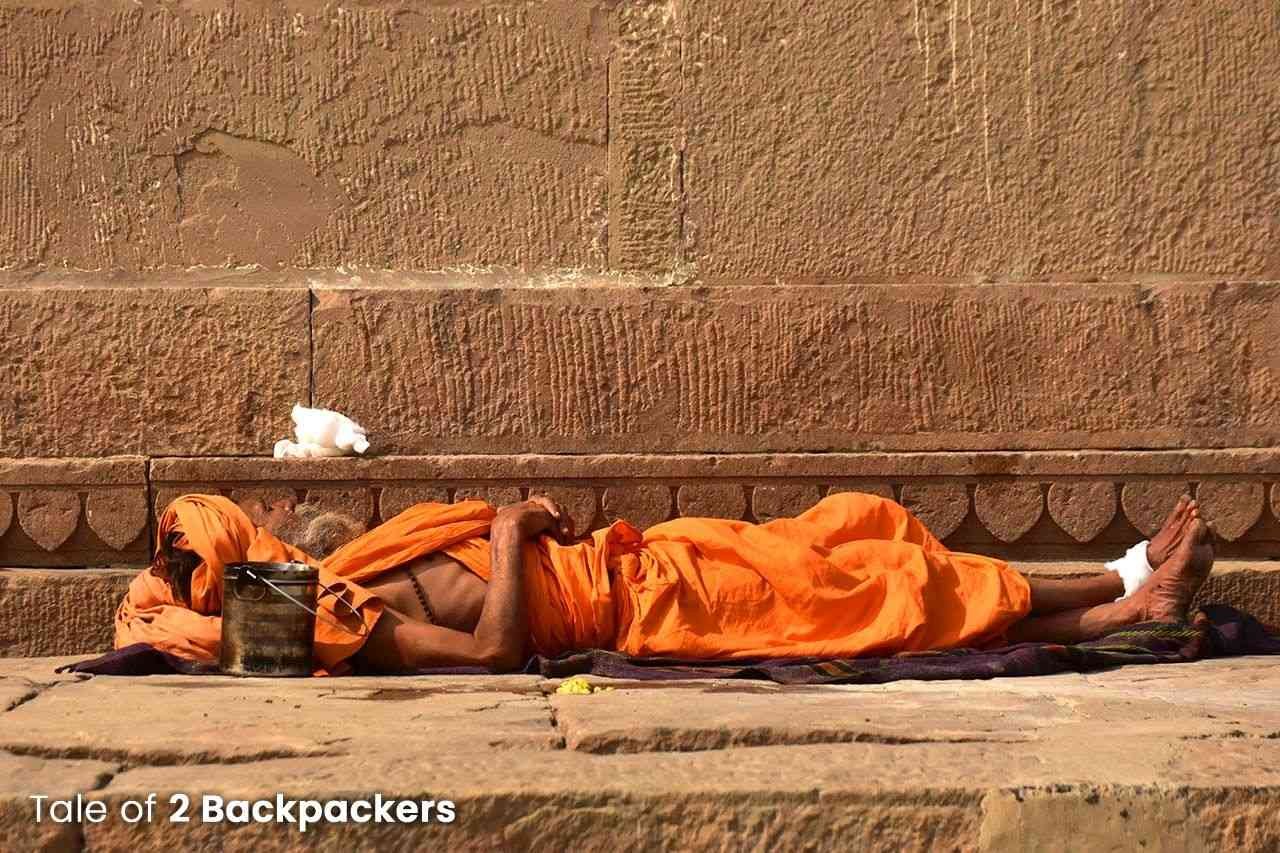
Where the River is the Goddess
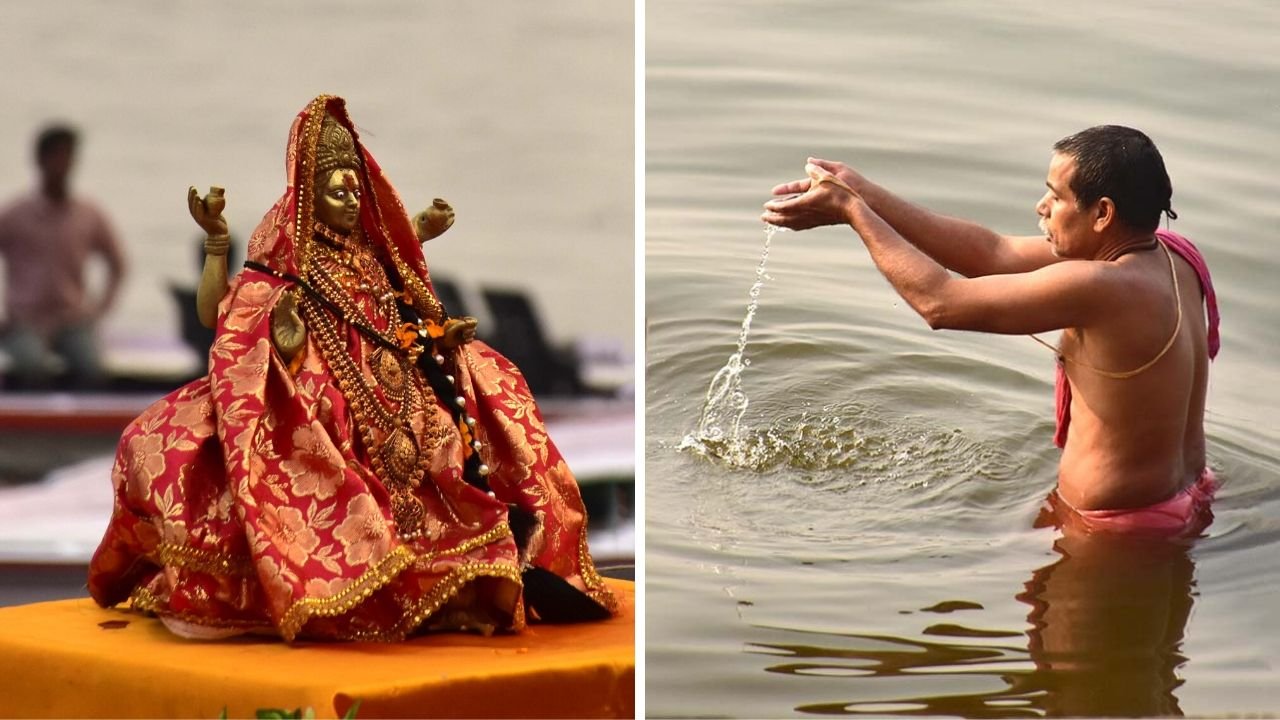
Varanasi is a place for all!
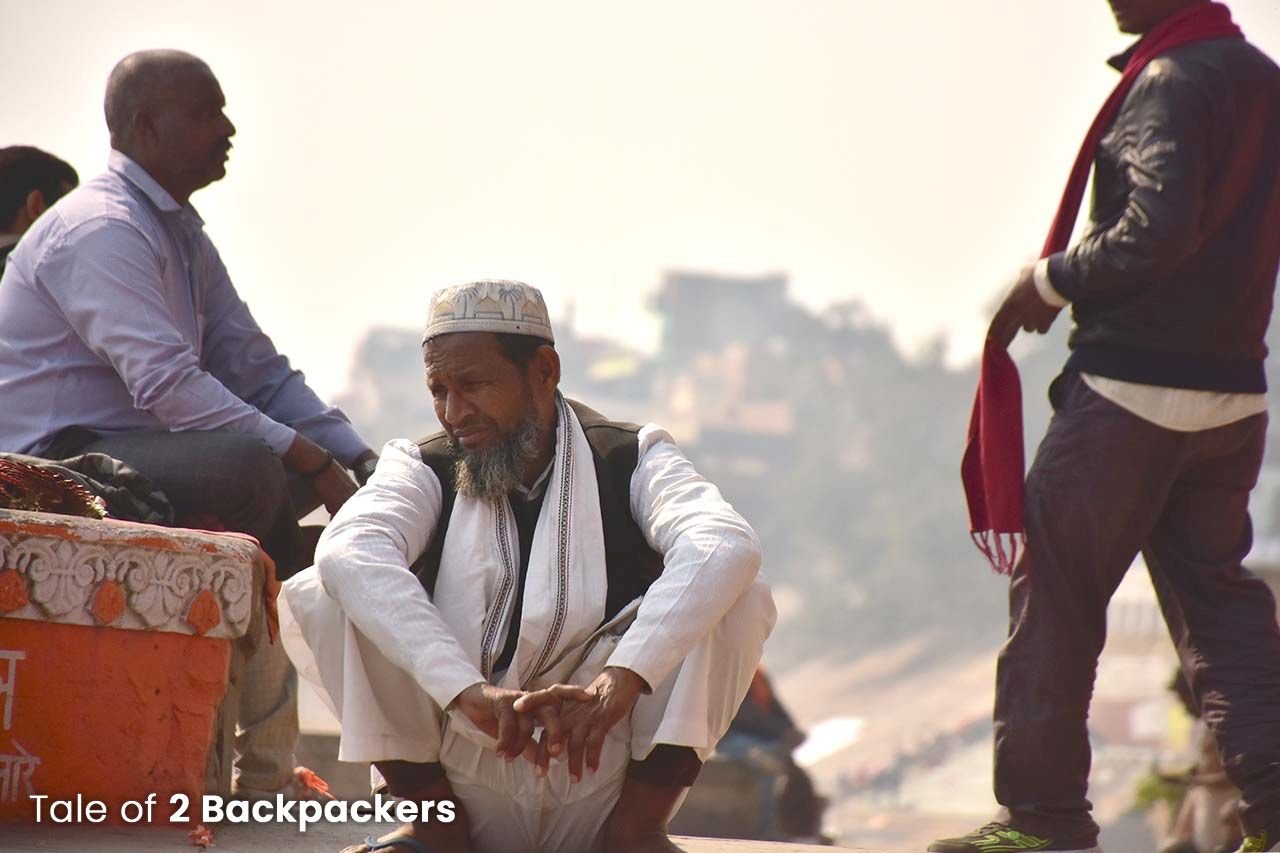
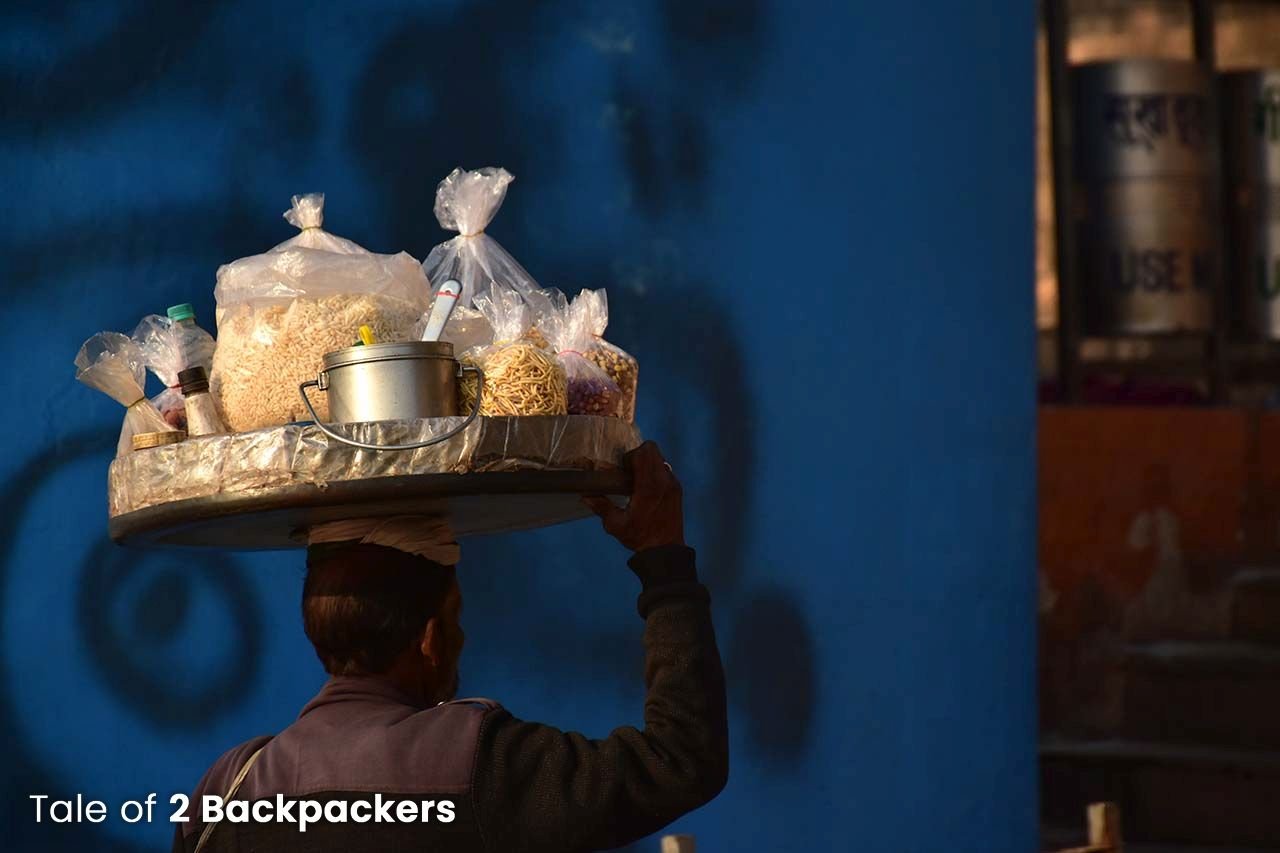
Taking away the filth

Prayers for the departed souls
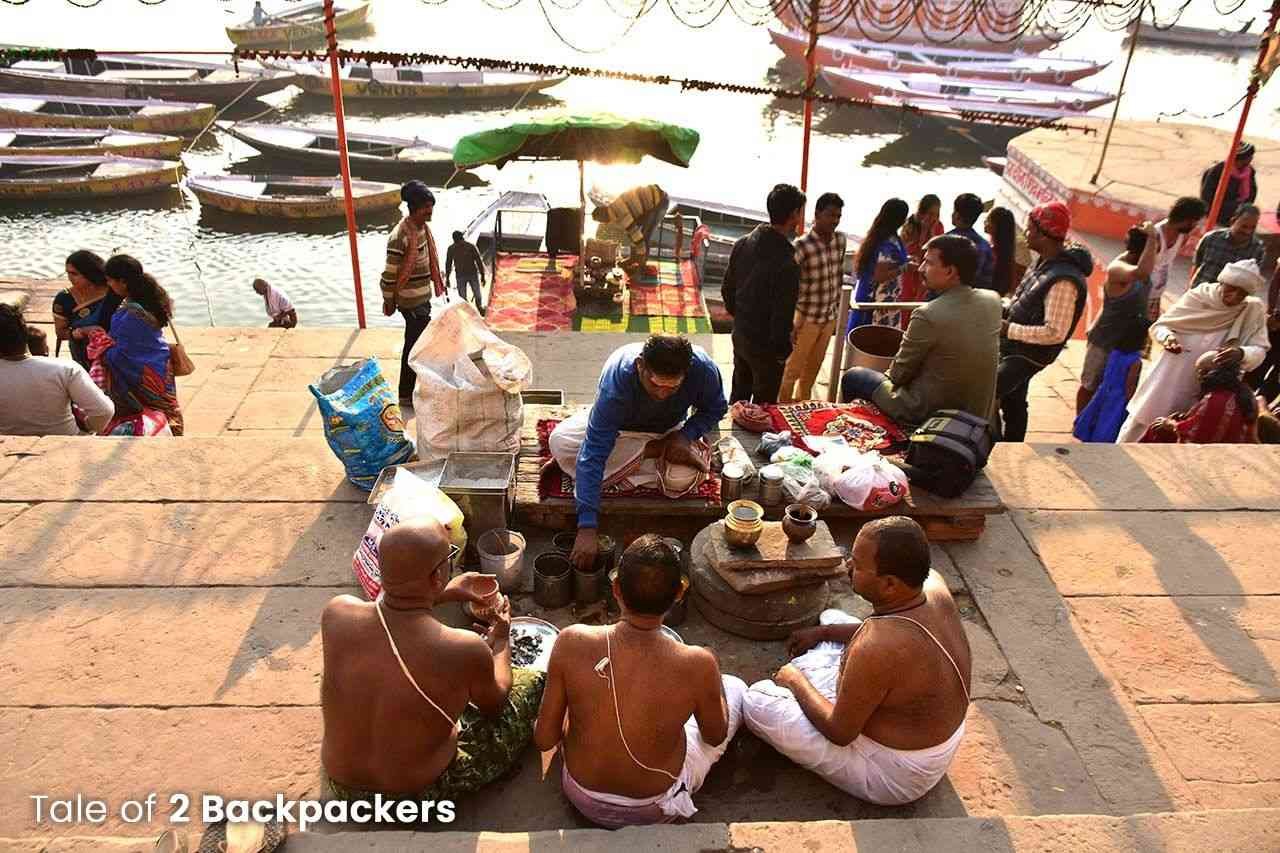
The Sadhus of Varanasi!

Life goes on!
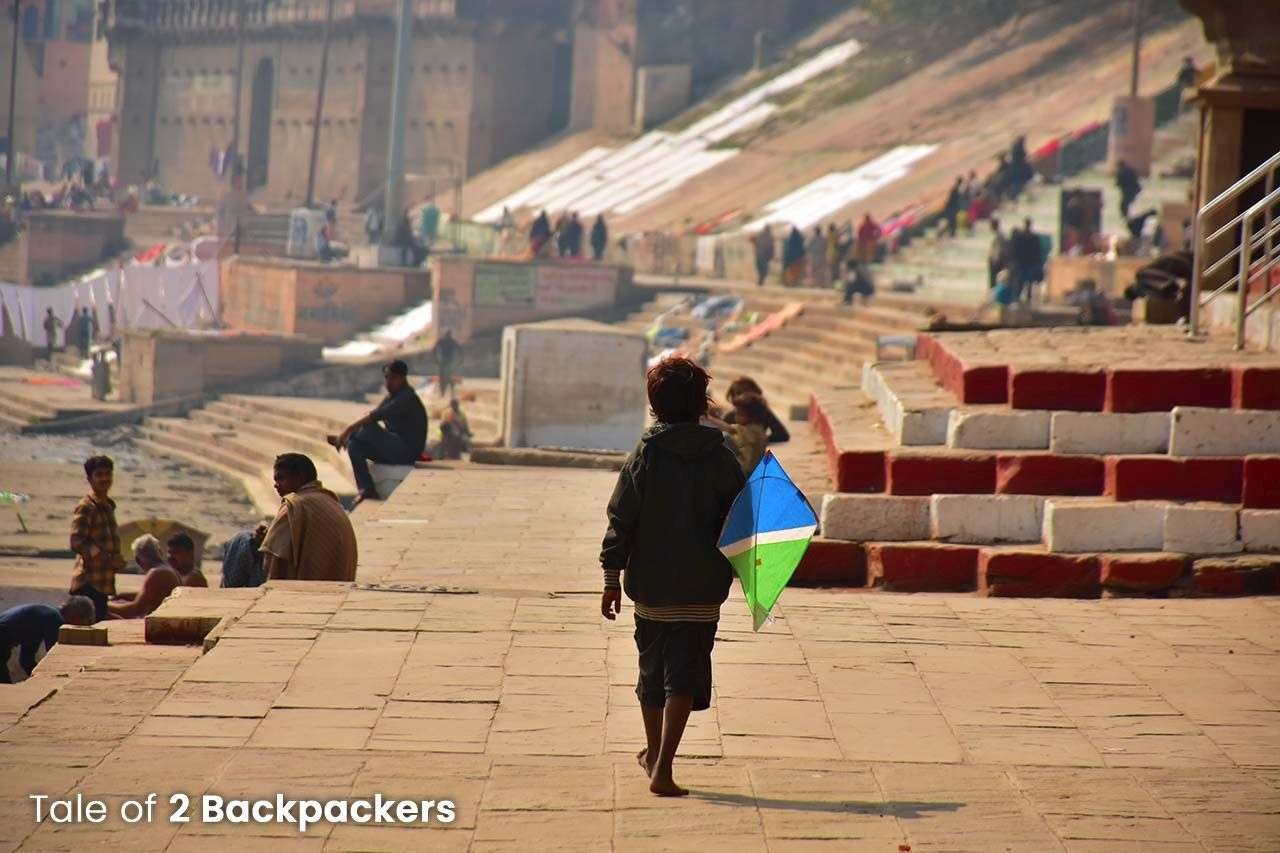
And the day ends!
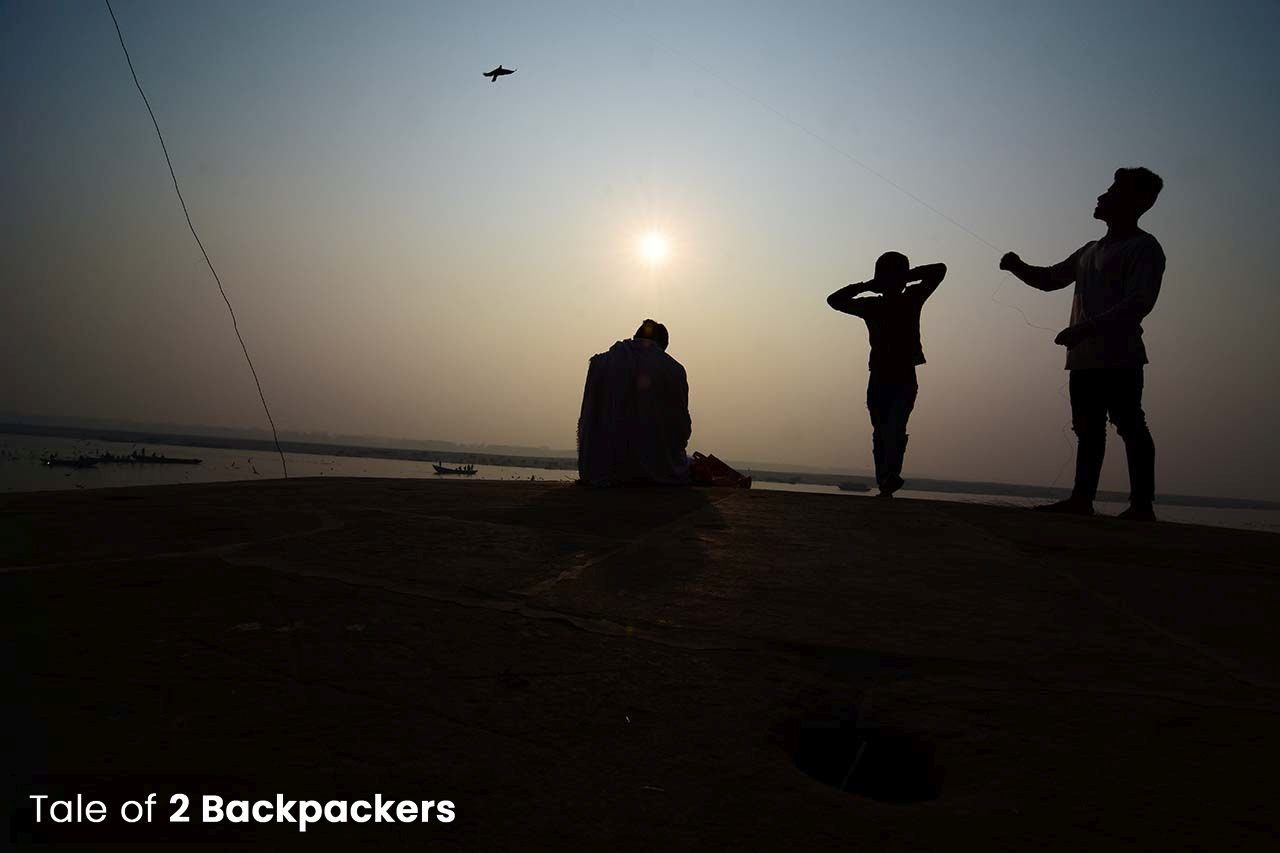
So that was our experience in exploring the Ghats of Varanasi. Hope you had a pleasant journey of the ghats with us. Do let us know about your views by commenting below. If you liked the post, please share it with your friends, family, neighbours and everyone!
Other resources on Varanasi
If you are planning to visit Varanasi for the first time or again, please have a look at our resources on Varanasi to help you plan your travel.
- Varanasi – the Complete Travel Guide
- Varanasi Street Food and the Best Places to Have them
- Quotes on Varanasi that describes the spirit and mysticism of the place
Pin this for a later read!
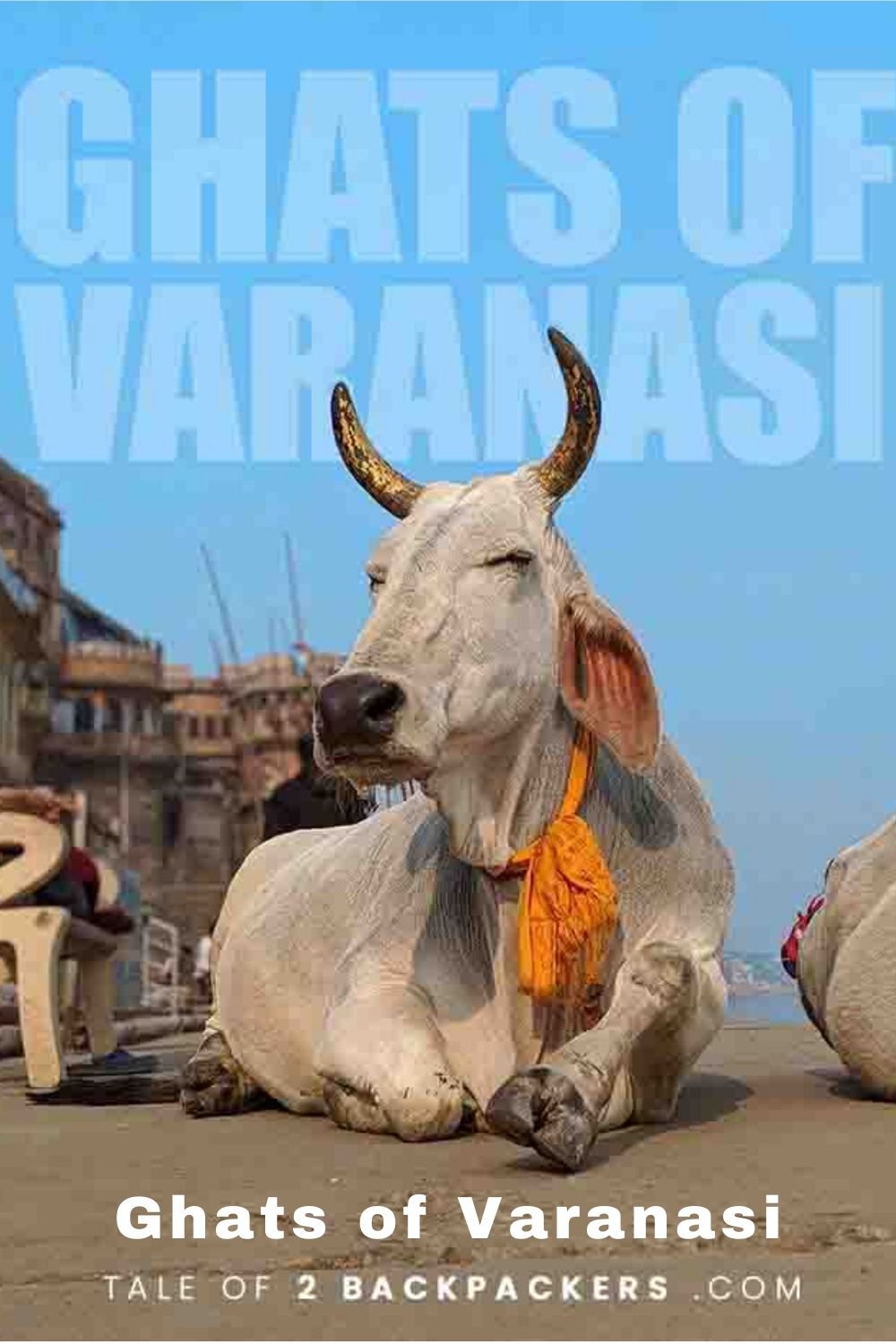




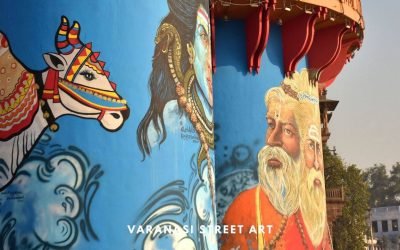
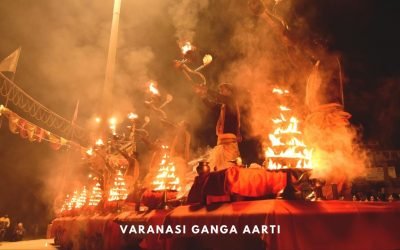

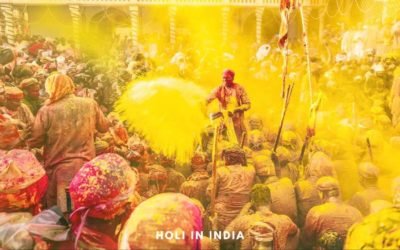
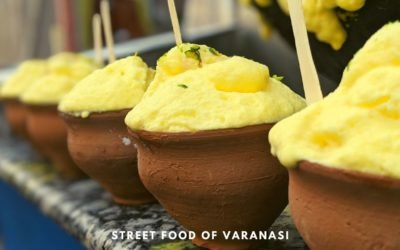
wow, impressive reserch. Great inside. I was in Varanasi in fall 2023. You answered so many of my questions. Beautifully done!
Thank you so much.
An excellent and informative article along with vibrant photos of Varanasi. I will visit for the first time in Varanasi in April-2023 and the article seems to be very helpful to gain first hand experience before my visit.
Thank you so much for the kind words.
Dear Agni Amrita,
Your write up about the ghats of Varanasi is beautiful and had a profound impact on me. I visited Kashi to immerse ashes of my late father at manikarnika ghat. Inspired by your artcile, I walked along the ghat from Assi ghat to Dashashwamedh ghat and the experience was blissful and unforgettable. Thank you.
Raghu.
Hello Raghu! First of all, our condolences for your loss. Hope you are doing good.
And thank you so much for such a beautiful comment. We are totally overwhelmed and humbled. – Agni & Amrita
Very vivid, you have described every ghat so nicely. Loved your photos!!
Thank you! Gaurav & Gunjan
Ohh! This was so enjoyable to read through! Especially the buffet of pictures you’ve got – really tells the whole story in a very beautiful way! Curious though, about how graffiti is so prominent there 🙂
Thank you! Even we were quite surprised to such vivid graffiti on the ghats.
forever in love with “Joy Baba Felunath”….as said correctly we Bengalis have a special connection with this ghats of Benaras. Thanks for such a comprehensive post guys, we are yet to visit this place. Which are your top 3 picks here
Thank you! And Joy Baba Felunath will always be close to our hearts! 🙂
The information on such a small place like Varanasi has blown my mind!! I had no knowledge about SO MANY things to do and see, no knowledge of these stories. Thank you for throwing some light 😀 This is the only guide I am sticking to when I travel to Varanasi.
Thank you so much, Parita!
Wow, that’s such a comprehensive article. Loved the way your described each and every ghats so beautifully with pics equally amazing..How about an article featuring best places to eat in Varanasi?
Hey Rajni and Yogesh, I also have a post on the street food of Varanasi!
I’ve visited India twice but have still not yet made it to Varanasi! I love how it brings back memories of your childhood for you – but that the city has improved since those childhood visits. I knew about bathing in the Ganges as a religious act for good health or luck but I had no idea that hundreds of dead bodies are burnt at the Varanasi Ghats, keeping the faith of the people alive – what a juxtaposition! That must be quite a shocking sight. Thanks for such an in-depth and personal account of Varanasi.
Thanks Laura for sharing your thoughts. I highly recommend you to visit Varanasi next time you are in India. The city is not like any other.
Such a detailed article about every ghat. The first time I landed at Varanasi somehow I did not like it, as it was crowded and dirty. But eventually, it grew on me, there is something about those ghats and narrow lanes. It was a press trip by Uttar Pradesh Tourism Board and Lonely Planet so we did not explore all the ghats apart from Assi Ghat and Manikarnika Ghat and explore the narrow lanes and devour on amazing street food. I would love to revisit and explore more ghats the next time.
Varanasi has that effect on everyone, I think. Do visit again and explore the ghats on the northern side.
TBH this is one of the most in-depth article about Varanasi and the Ghats that I’ve come across. Kudos to you both. Any one travelling to Varanasi would be able to make sense of things, 10 times better if they read this as part of their pre trip research. The wall arts in the Ghats of Varanasi are indeed an attraction in themselves. Its not something that you will expect in a holy city.
Thank you, Arnav!
Varanasi is incredible and intriguing. It is a city that touches the core of your heart in ways you would never have imagined. A city that in many ways symbolizes the ephemeral nature of life. This post is a wonderful tour de force of the Ghats of Varanasi, which is undoubtedly the heart of Kashi.
You have summarised the essence of Varanasi so nicely. Thank you for sharing your views.
Like you Varanasi is also one of my favorite cities, having stayed there for four years. And your post brought back beautiful memories of all the Ghats. What is so good and what makes me happy is that it is so clean now as I experienced during my last visit there after which I too wrote two posts about my experiences there. I believe every person should visit Varanasi at least once. I keep visiting every year at least once.
I totally agree that everyone should visit Varanasi at least once! Thank you for sharing your views with us.
I visited Varanasi last year with my mom. Even though I did not see so many ghats, but I did see the Ganga Aarti from the Assi Ghat. And I took the boat ride to pass through the ghats. I loved listening to the stories from locals and how each ghat has a story of its own. Absolutely fascinating.
Varanasi is itself fascinating. Thanks for sharing your views, Raksha.
It is such a great article. So many memories returned. I was in Varanasi in 2008; I spent several days trying to understand customs, culture, religion. But it was a challenging experience for me. It was my first non-European trip. The rites over the holy water and ghats in Varanasi moved me. I understood the sign of the cycle of life and death at the sacred Ganges River. It was a magical experience. I would like to back there one day.
Thank you Agnes, for such a beautiful comment. First time in Varanasi can be quite overwhelming.
Wow what an interesting post. Something I have never really heard about so was an interesting read. I would love to take a boat ride to if i get to visit thats for sure. The wall art is also so intriguing as it really mixes up the dynamic of the ghats. I found the tale about the Chet Singh Ghat especially interesting as being a brit and I had never heard about this!. Thanks for sharing!
Thanks Emma! India has many such interesting tales about Brits and equally interesting places.
I would definitely visit the Dashashwamedh Ghat and stay for Arti of Varanasi. It sounds like this is a great place to people watch, and good tip to try not to be a gullible tourist! The Brijrama Palace at the Darbhanga Ghat looks incredible. I’m unsure about visiting the Manikarnika Ghat, I wonder if I would feel as though it is disrespectful to be there as an observer.
Brijrama Pallace is one of the best places to stay in Varanasi. And I am sure you will enjoy the Aarati at Dashshwamedh Ghat.
Wow- I can’t beleive I actually found a blog that talks about the significances of each ghat in Varanasi. Usually I’ve just seen these names being listed down in “things to do” and never actually found the difference and speciality of each of these. Kudos to you for taking the time to actually learn about the place you’re visiting, very few people do that! And your description of Varanasi really had me. The feeling of serenity in chaos is always a fascinating feeling. Would love to go around Varanasi some day 🙂
Thank you, Avantika! Varanasi is a special place and the ghats are like the essence of this ancient city. Thank you for sharing your views.